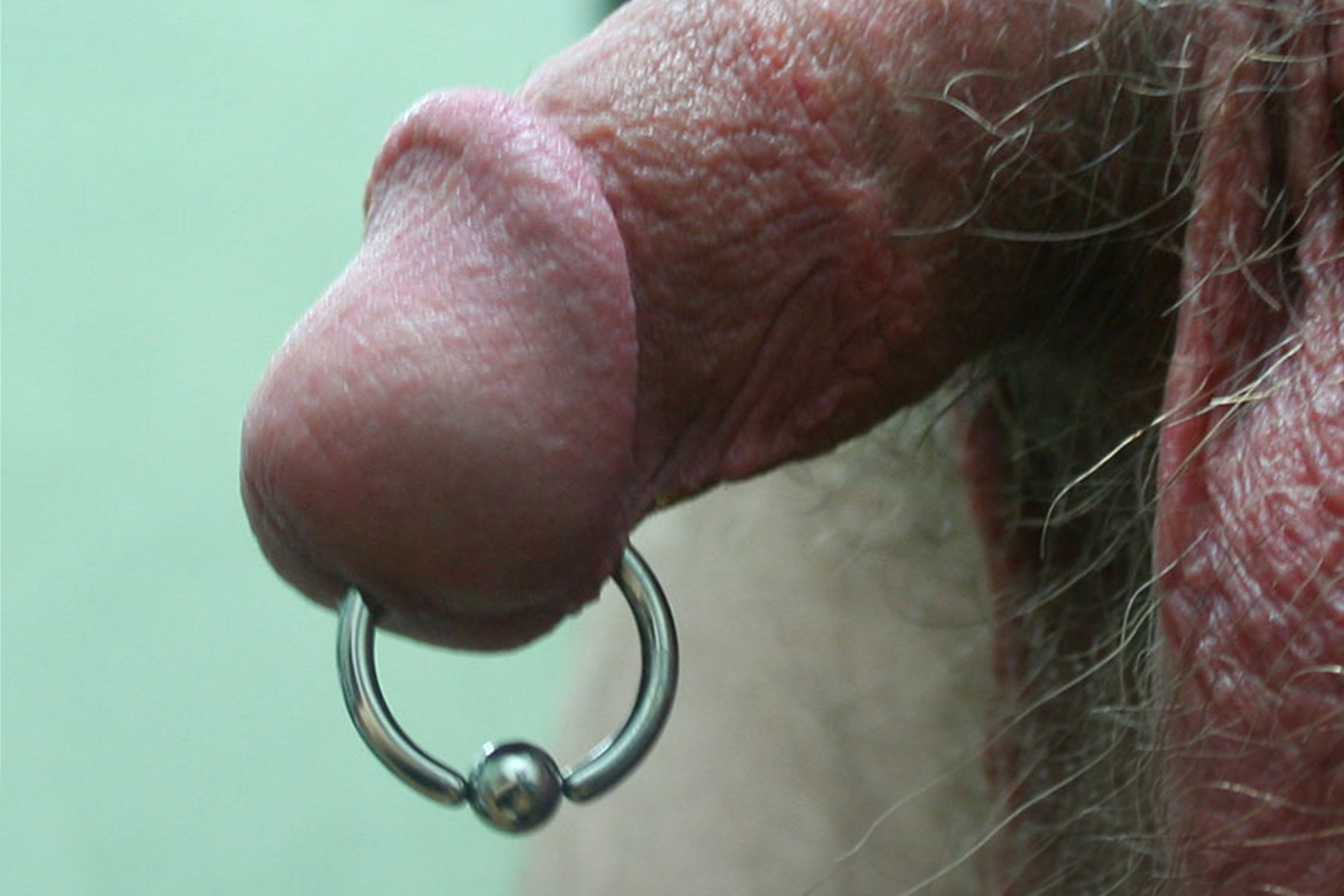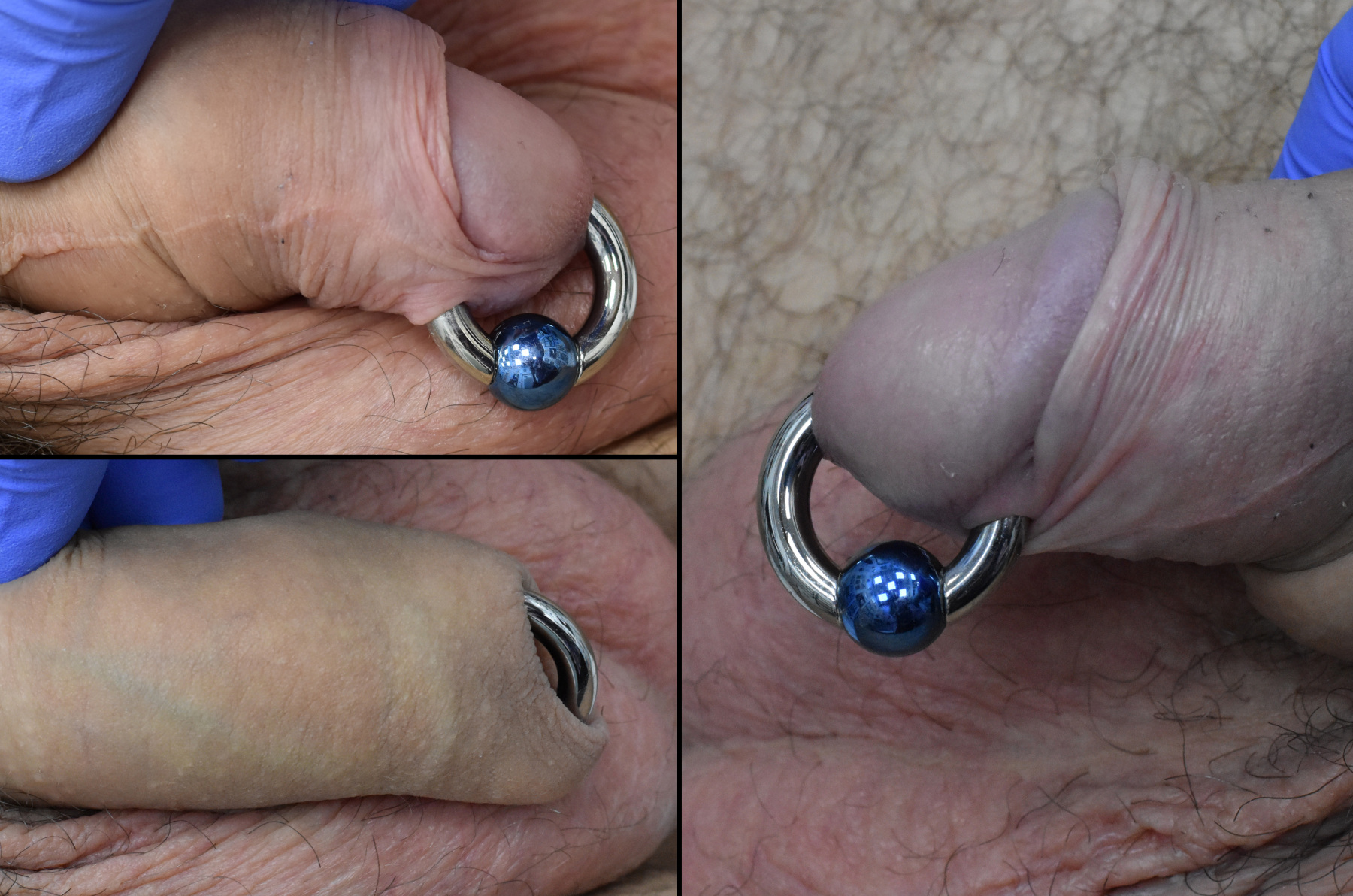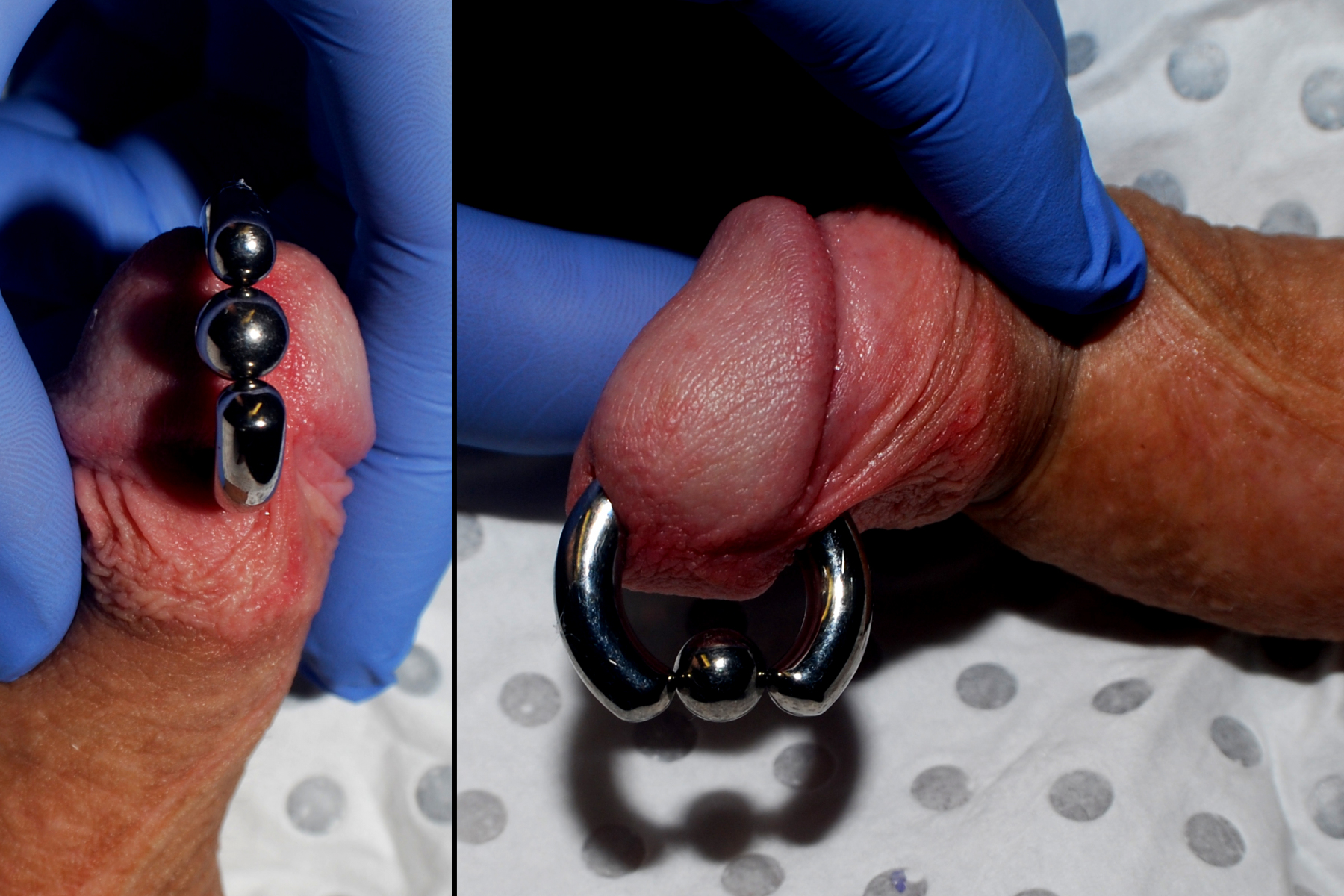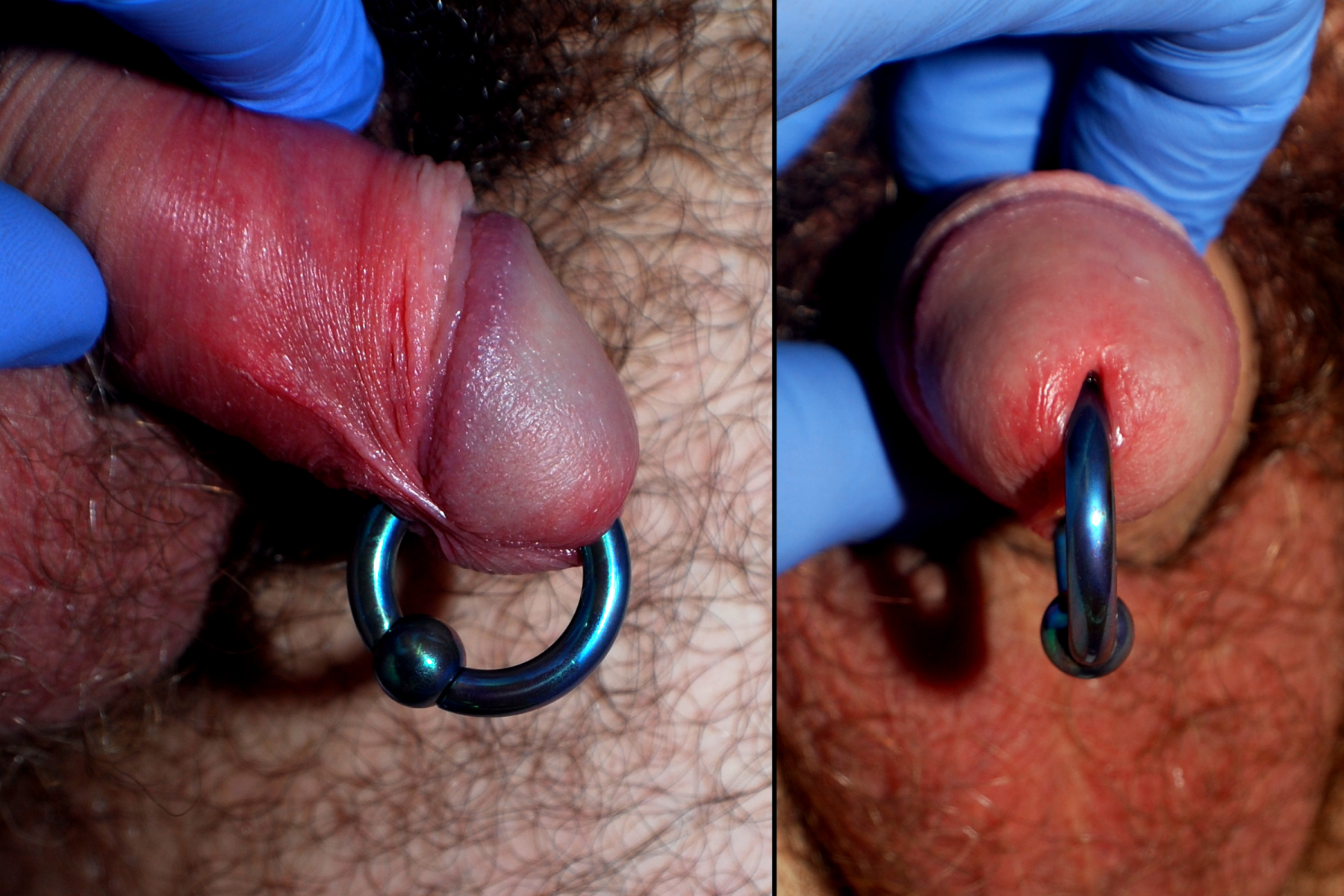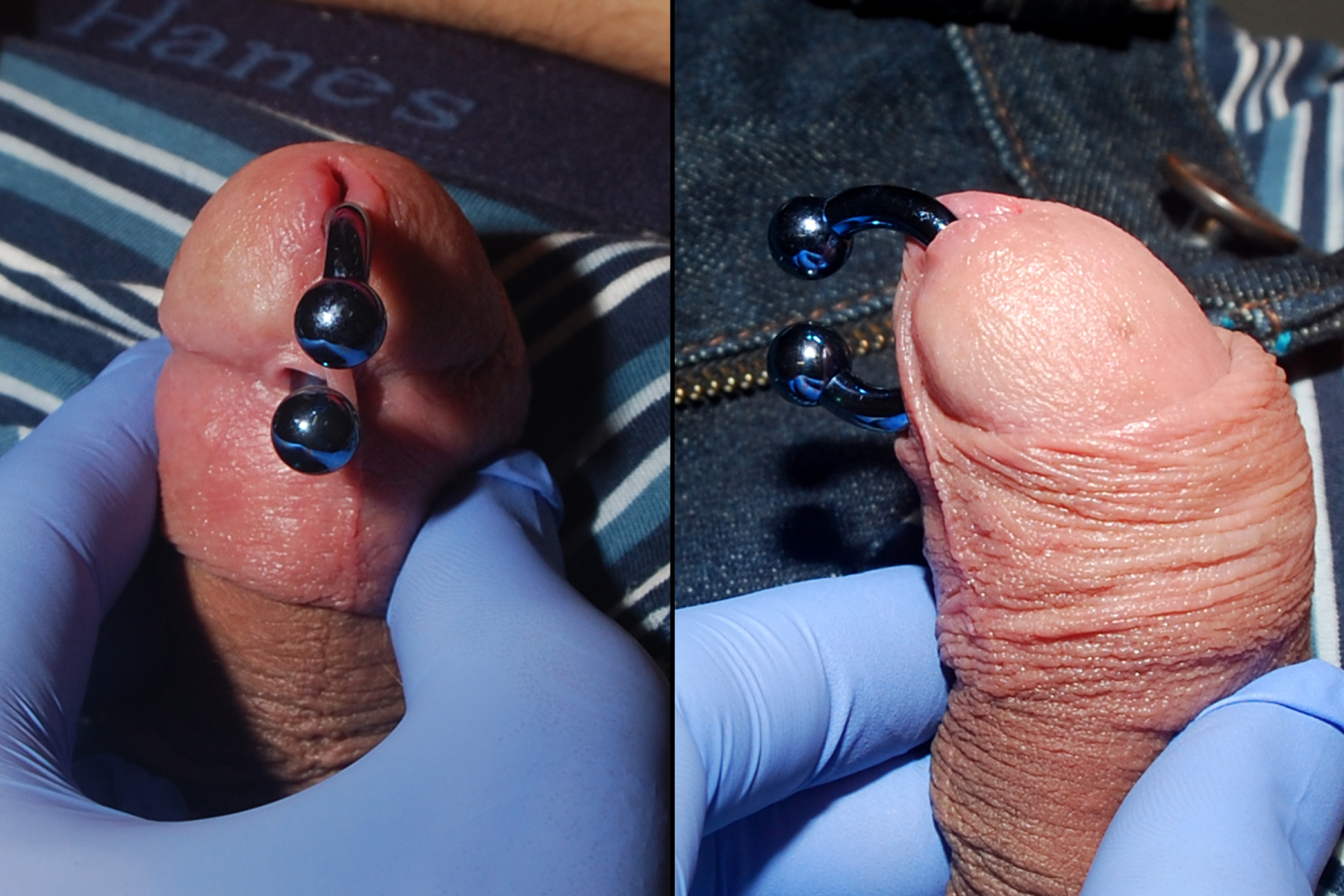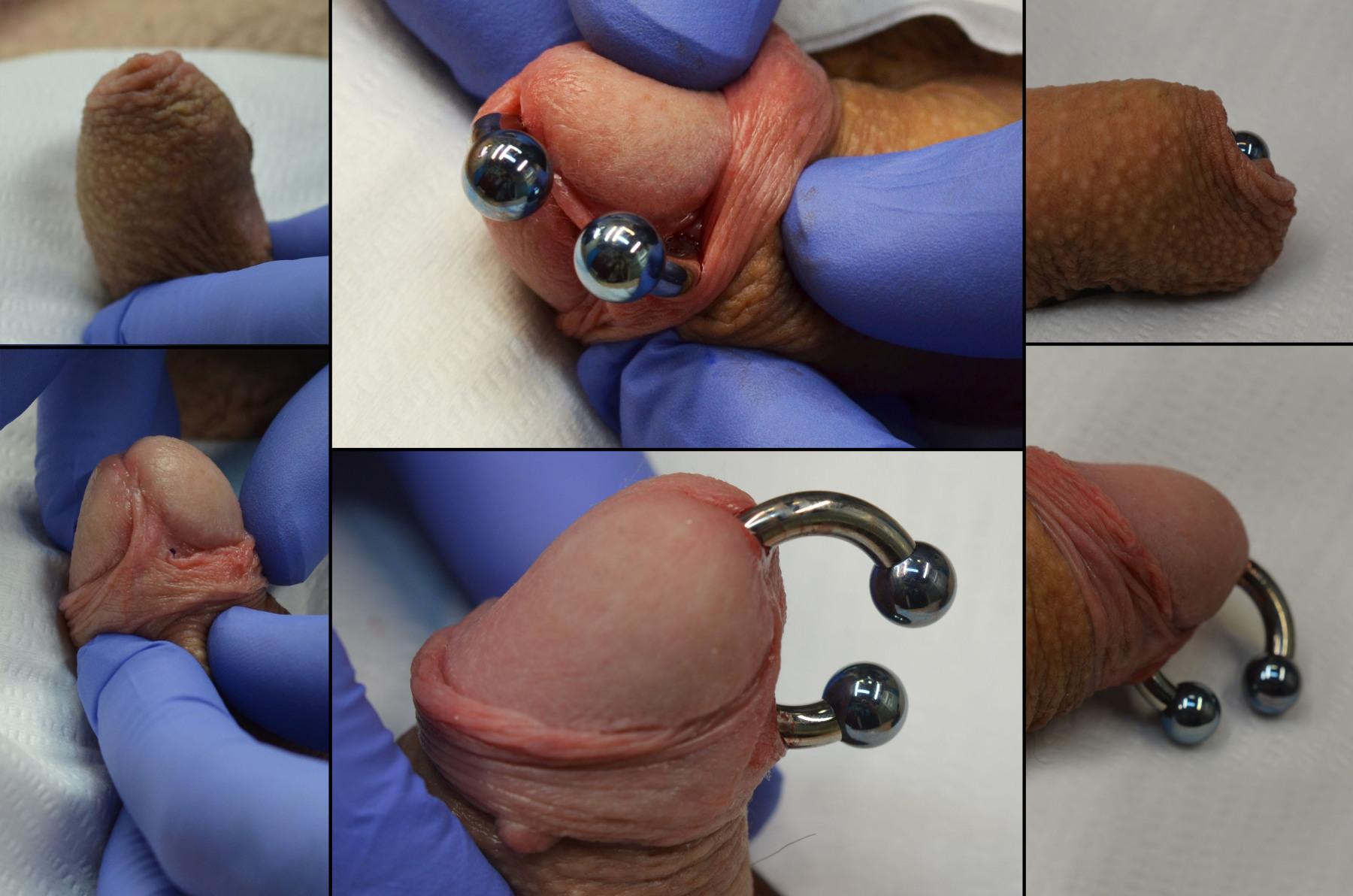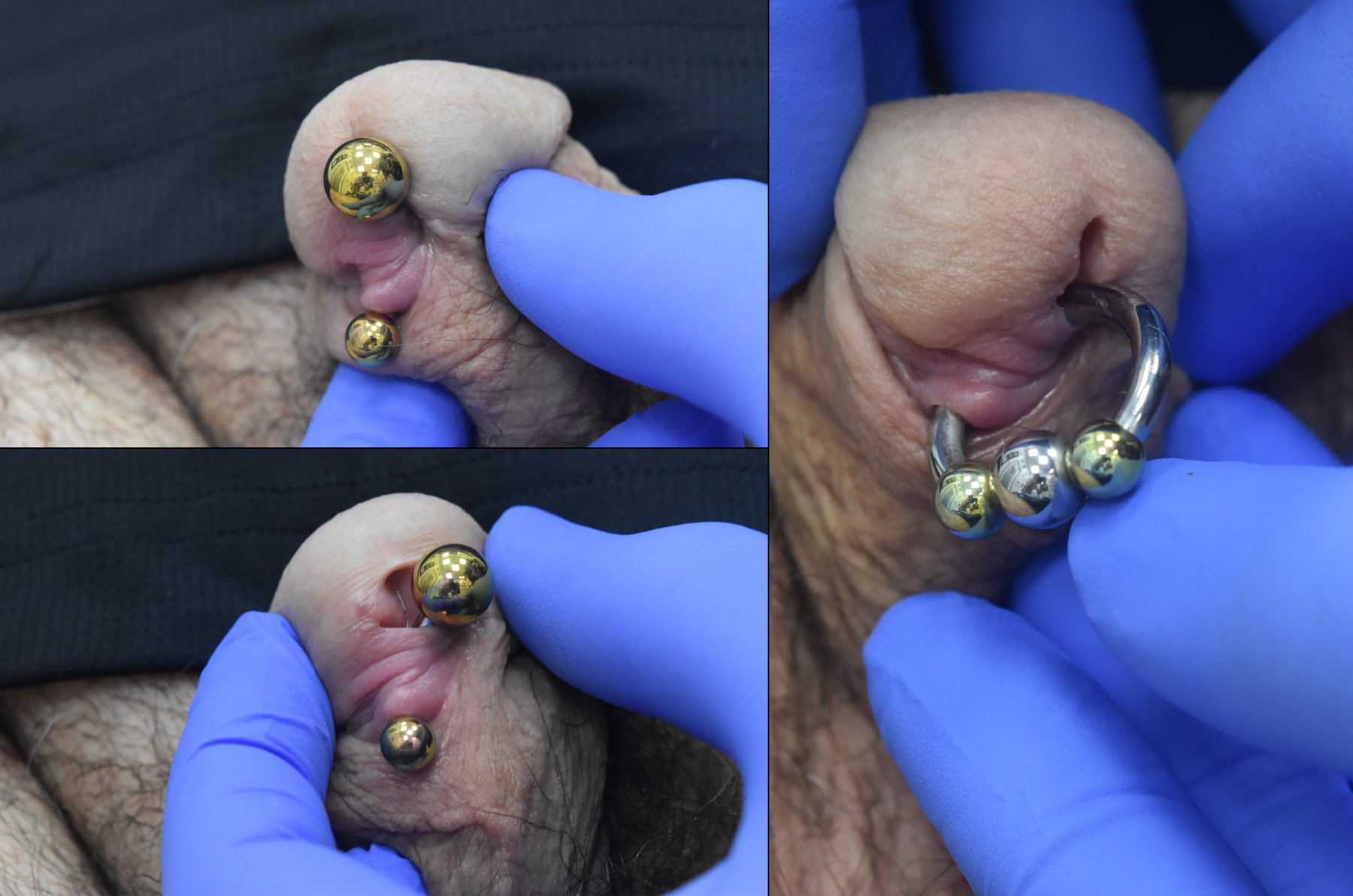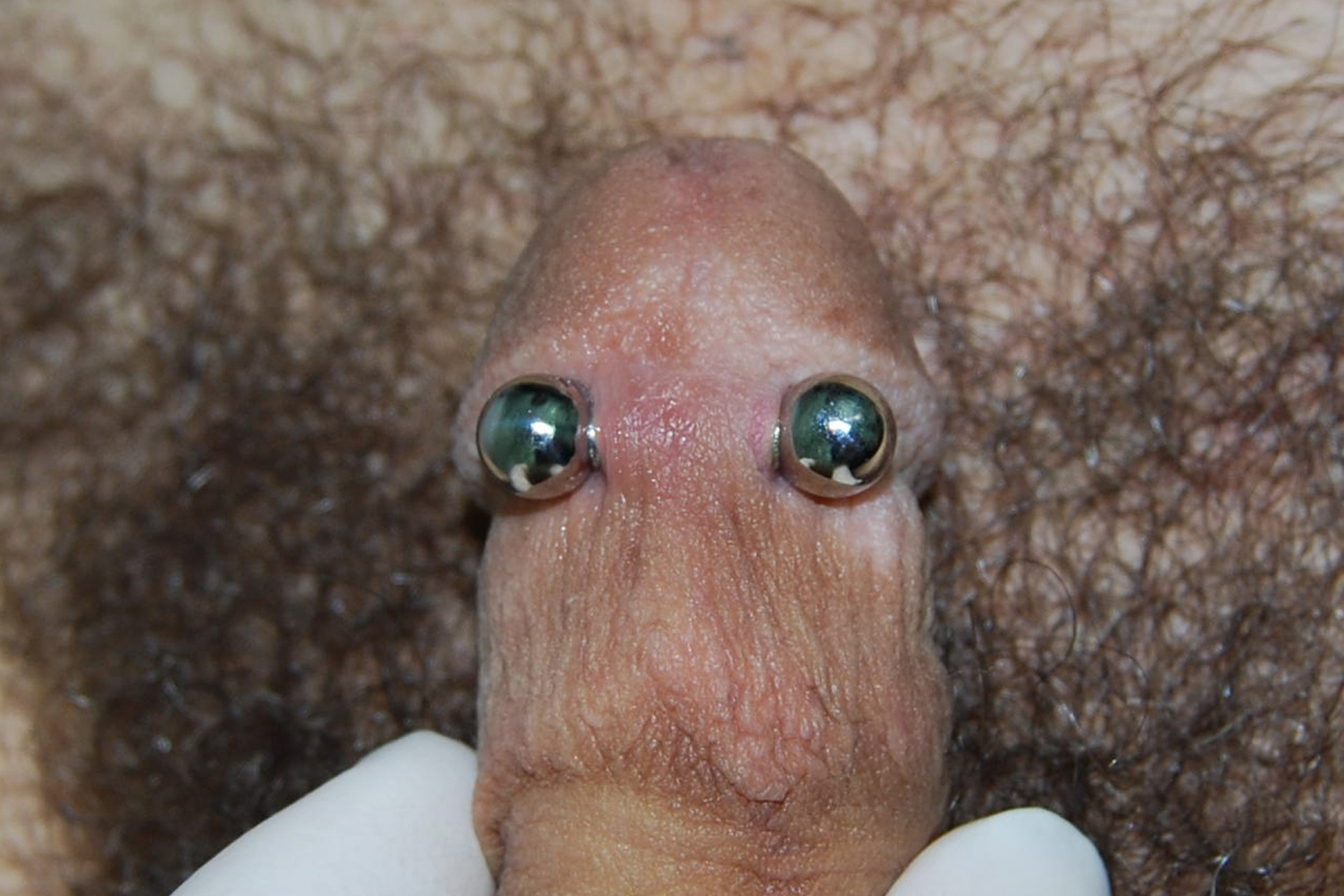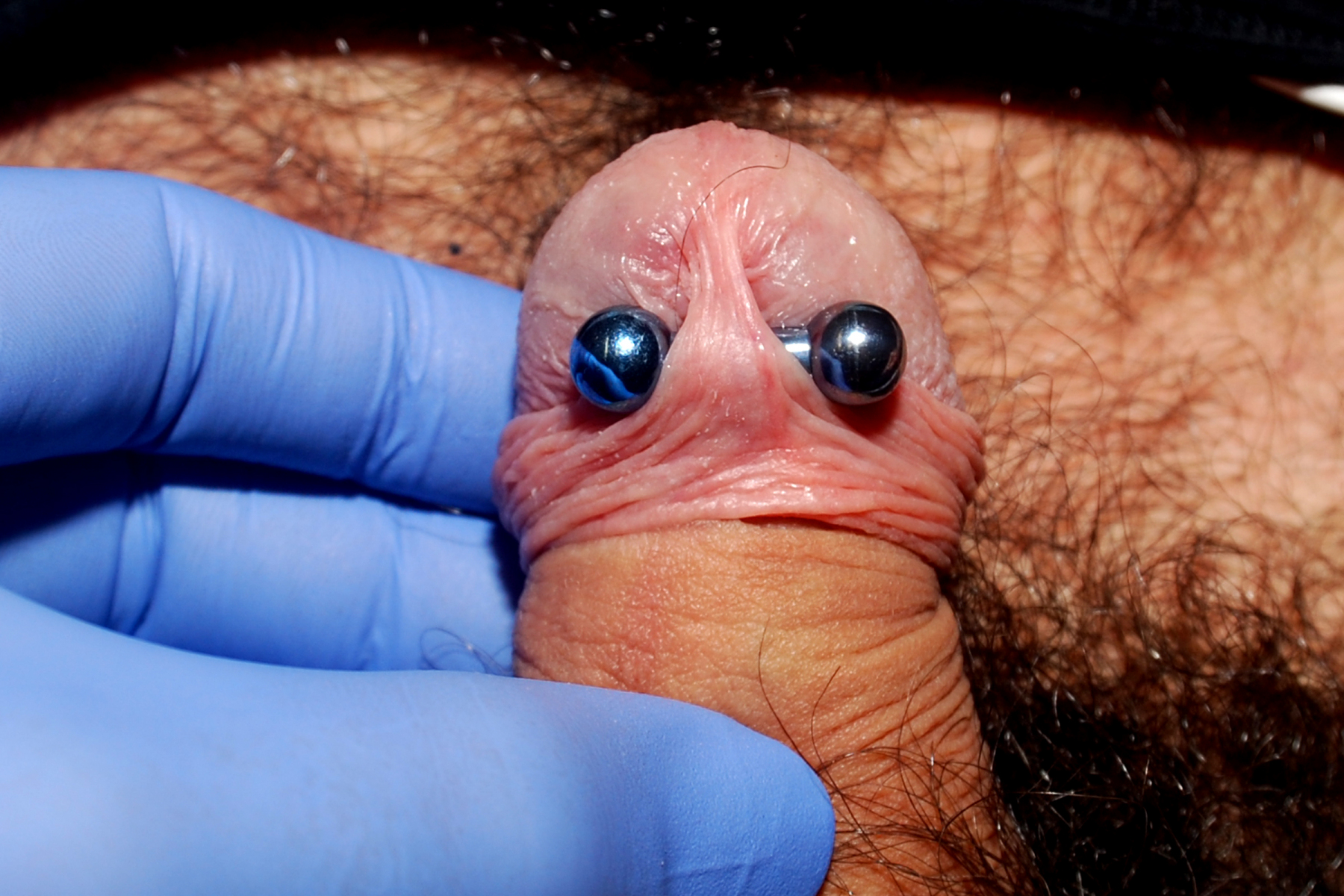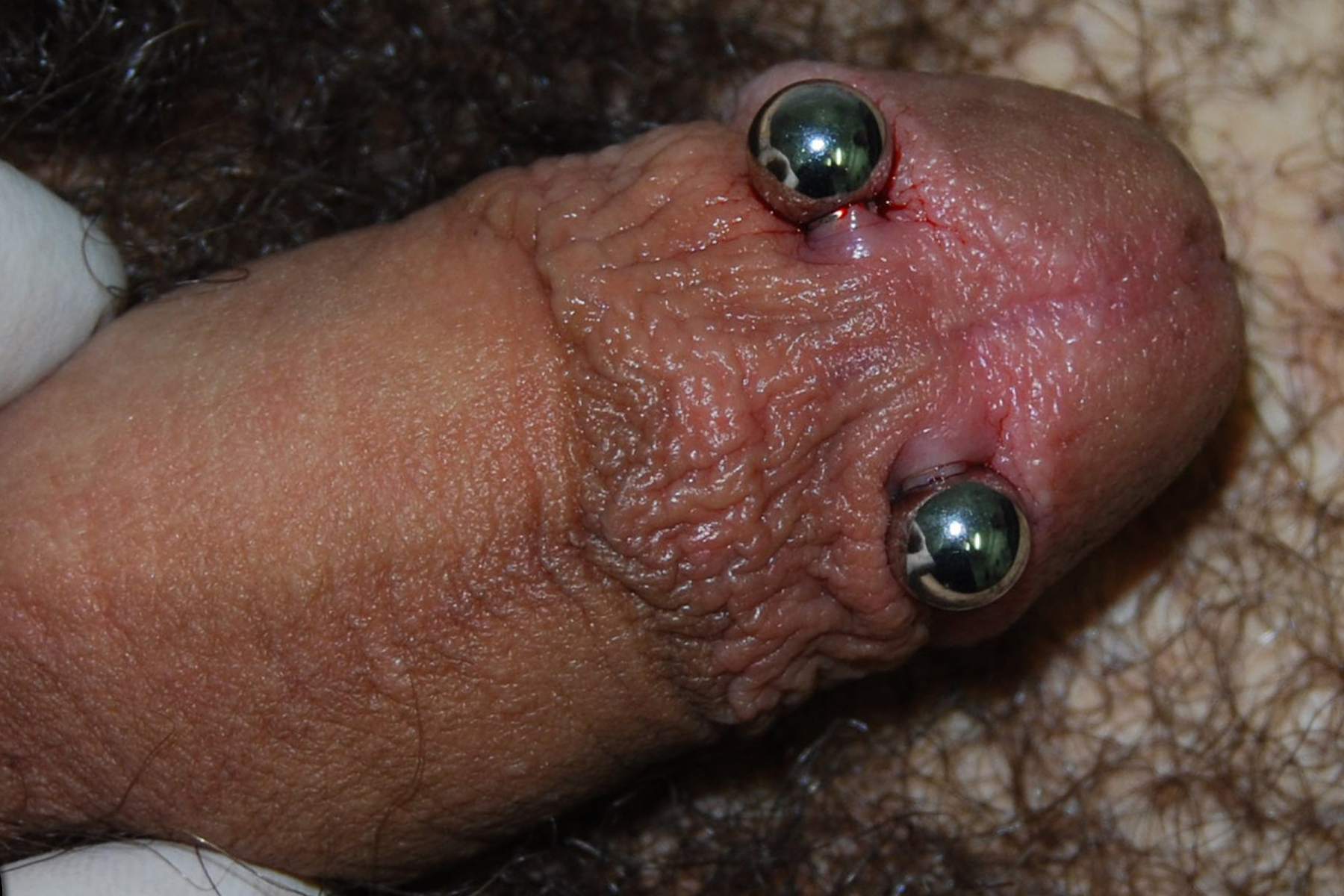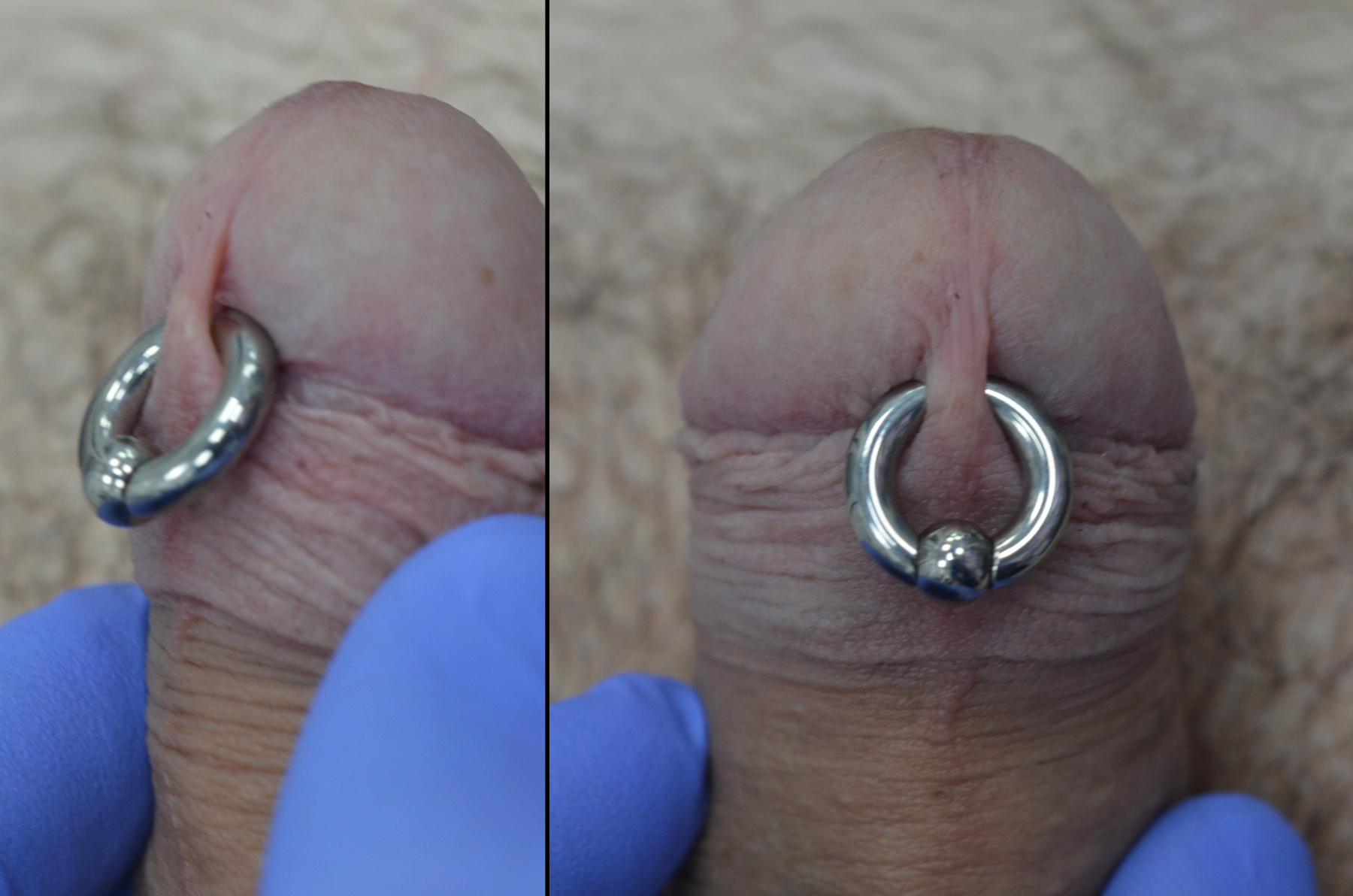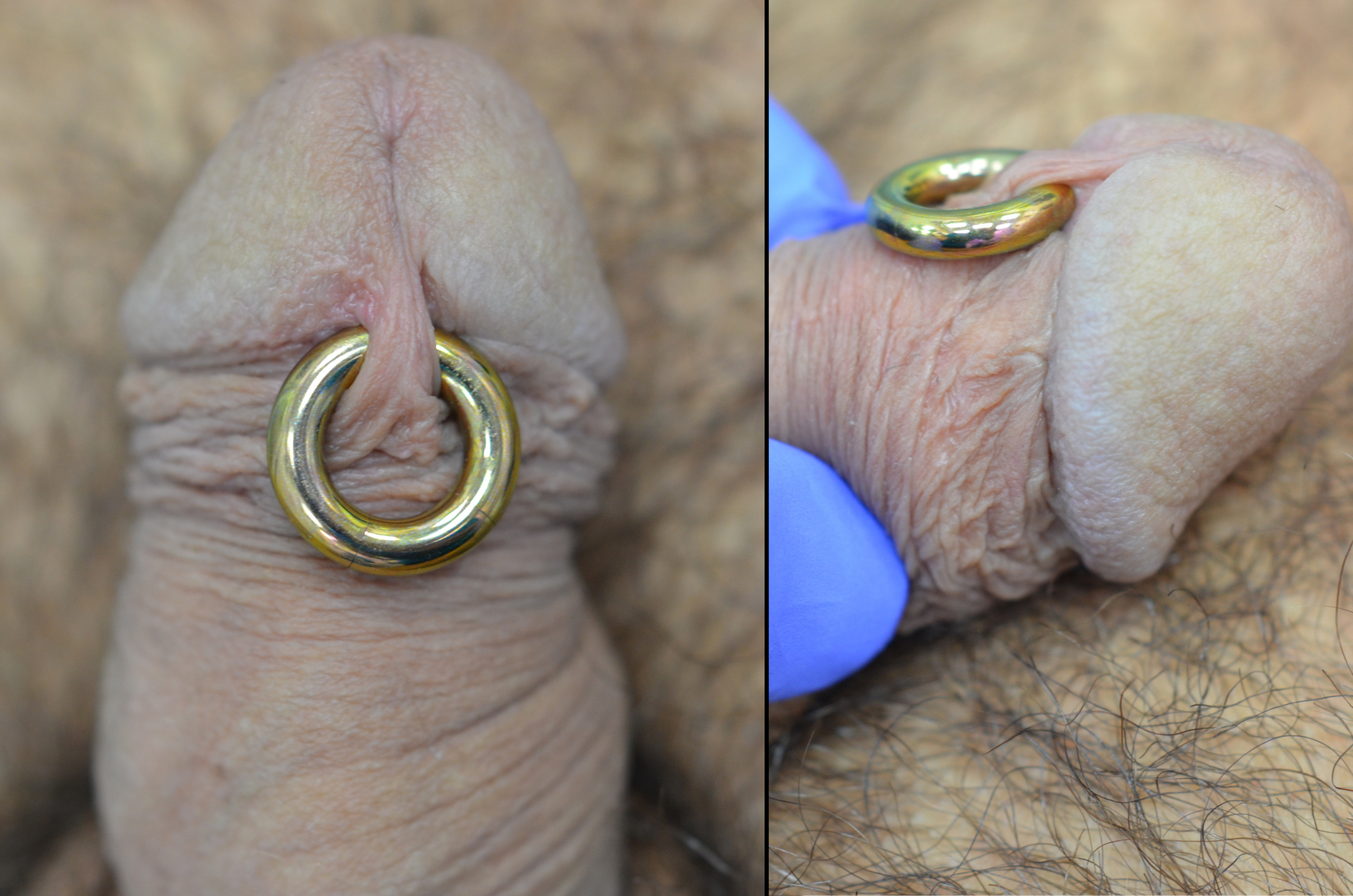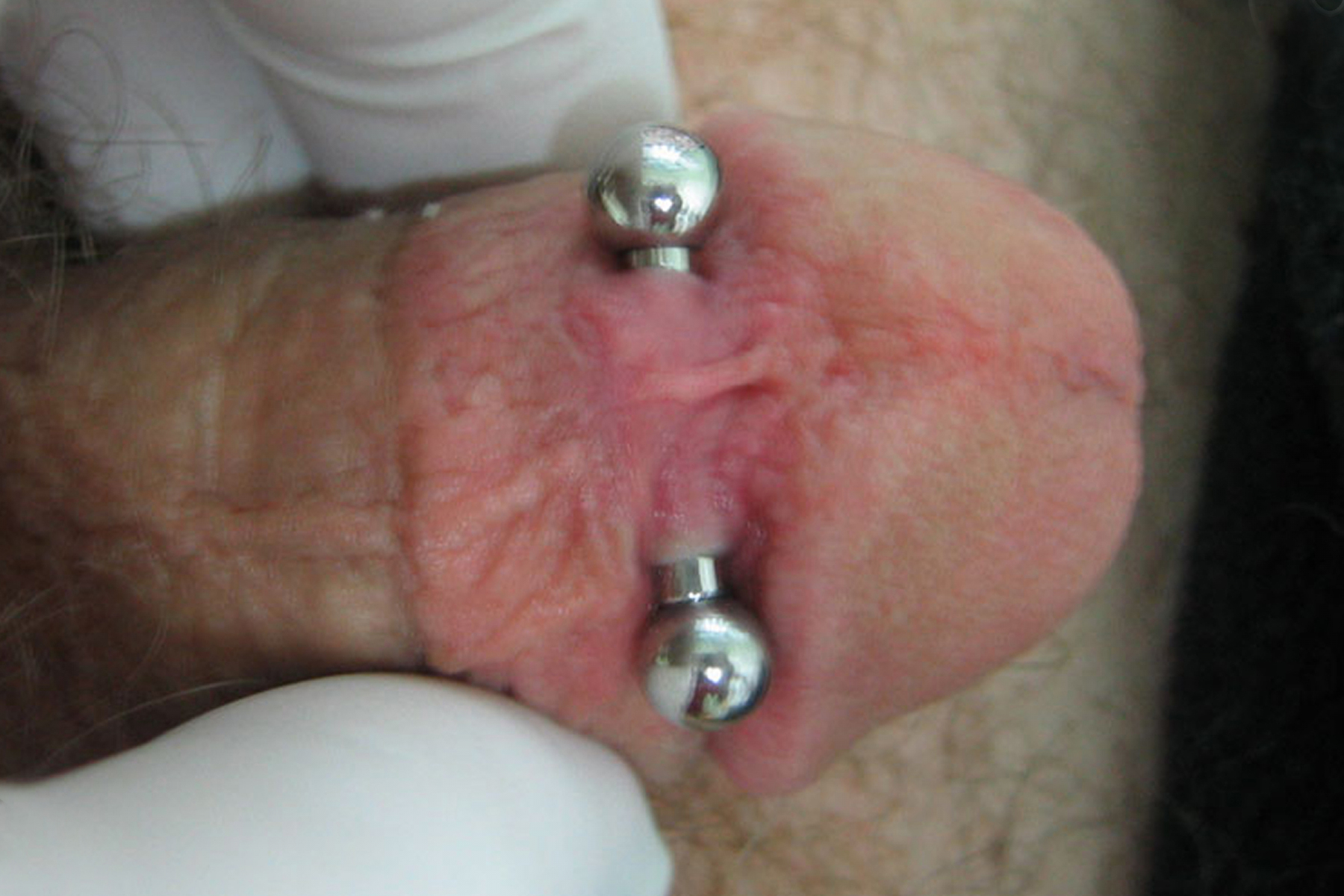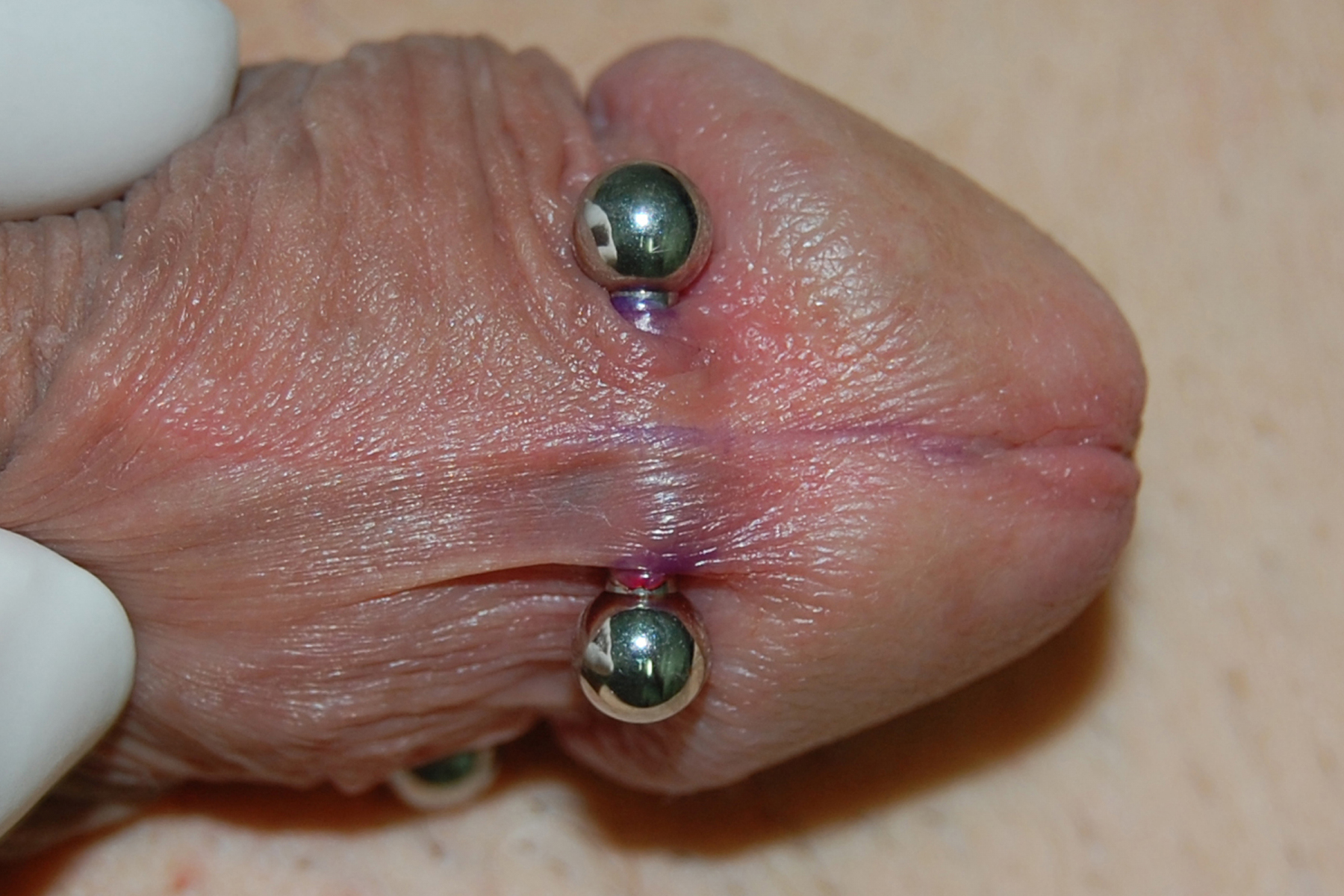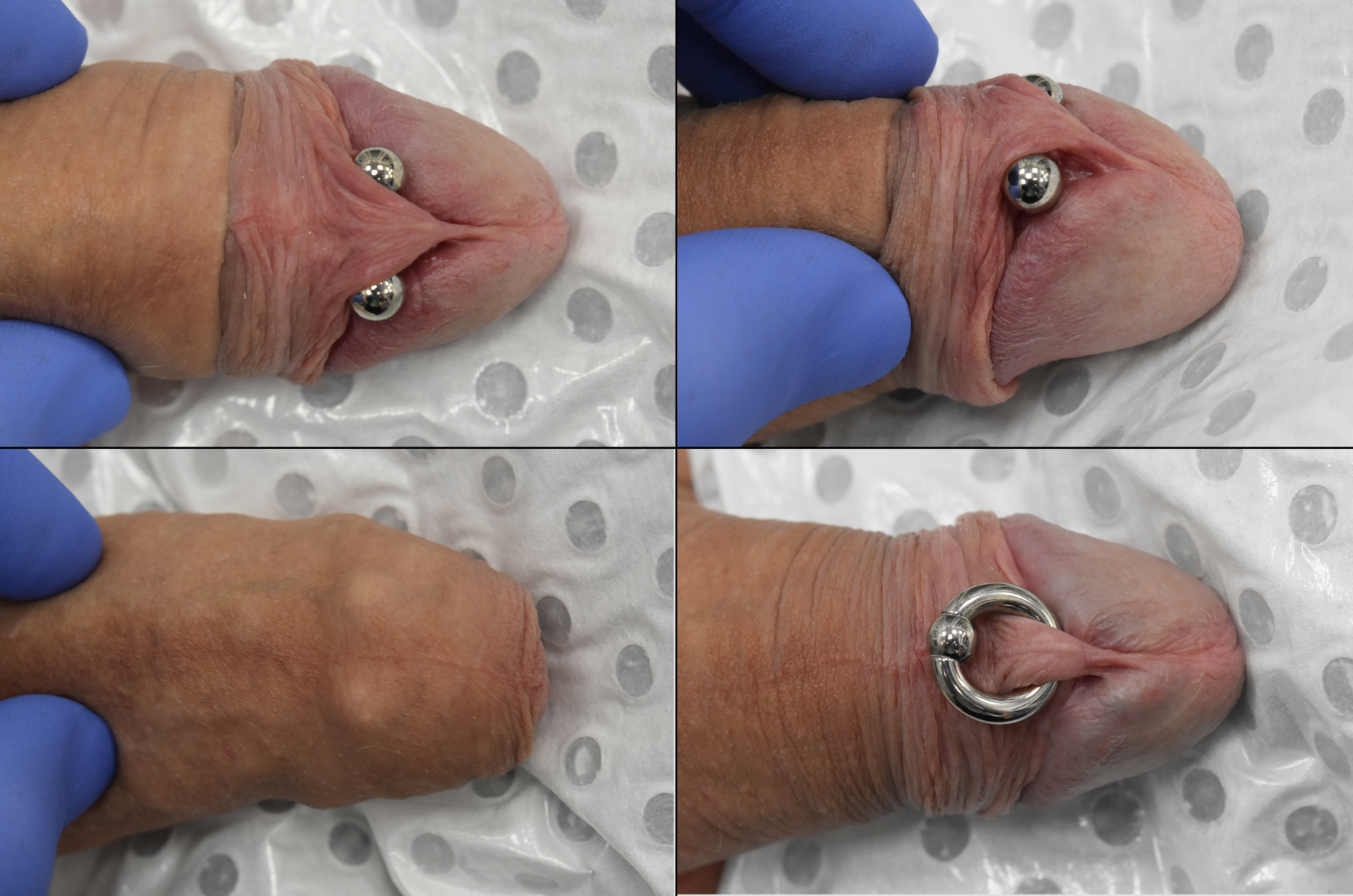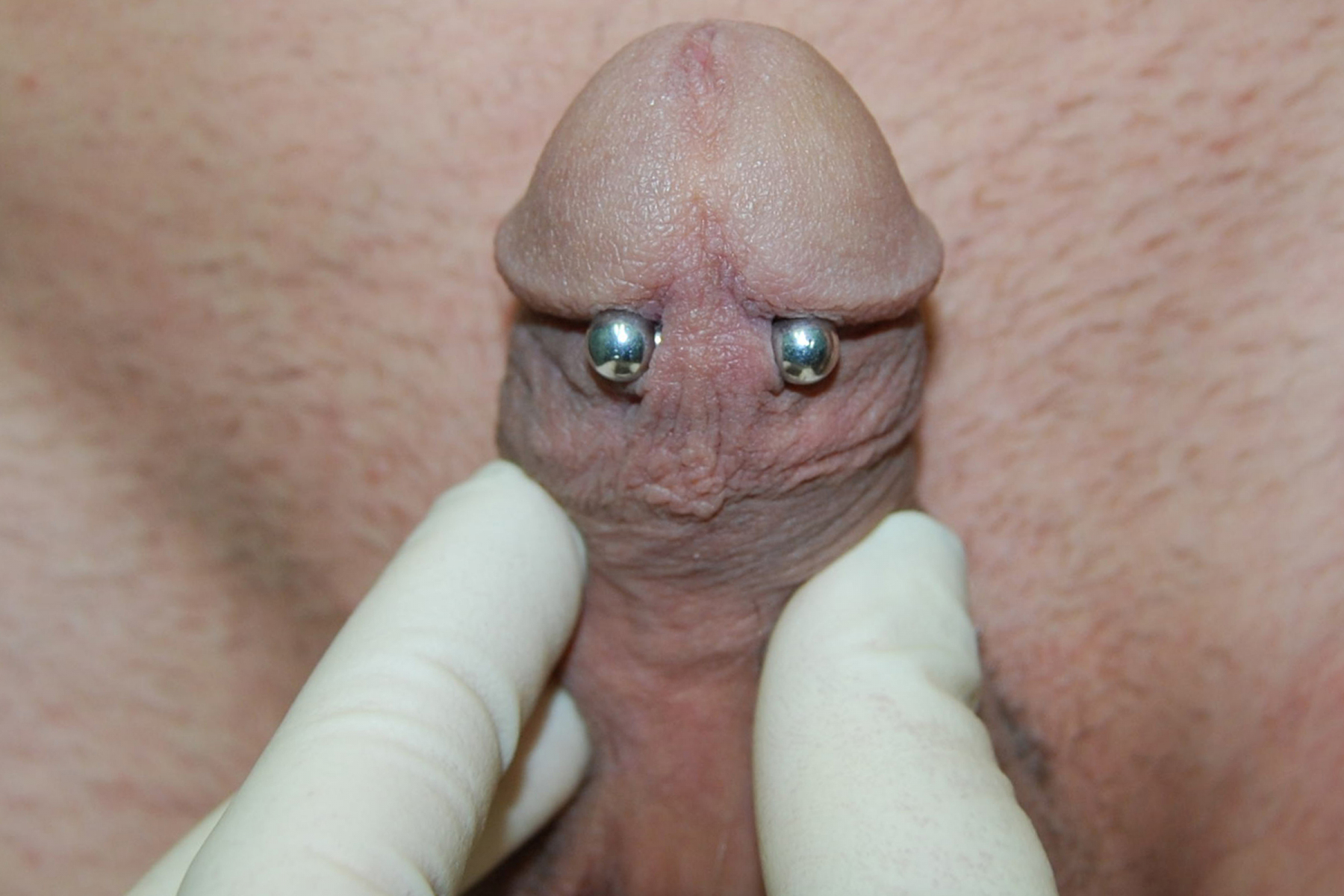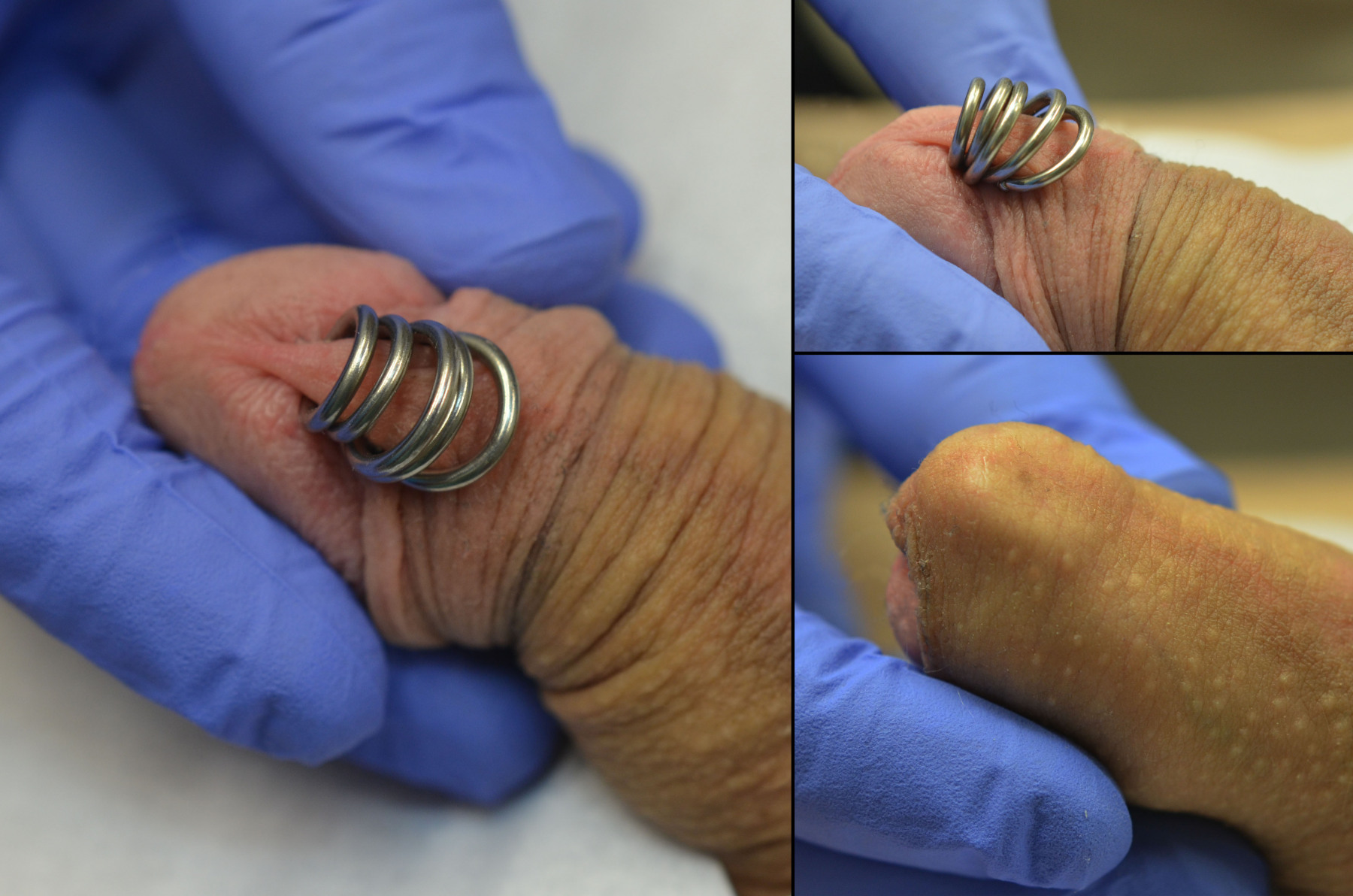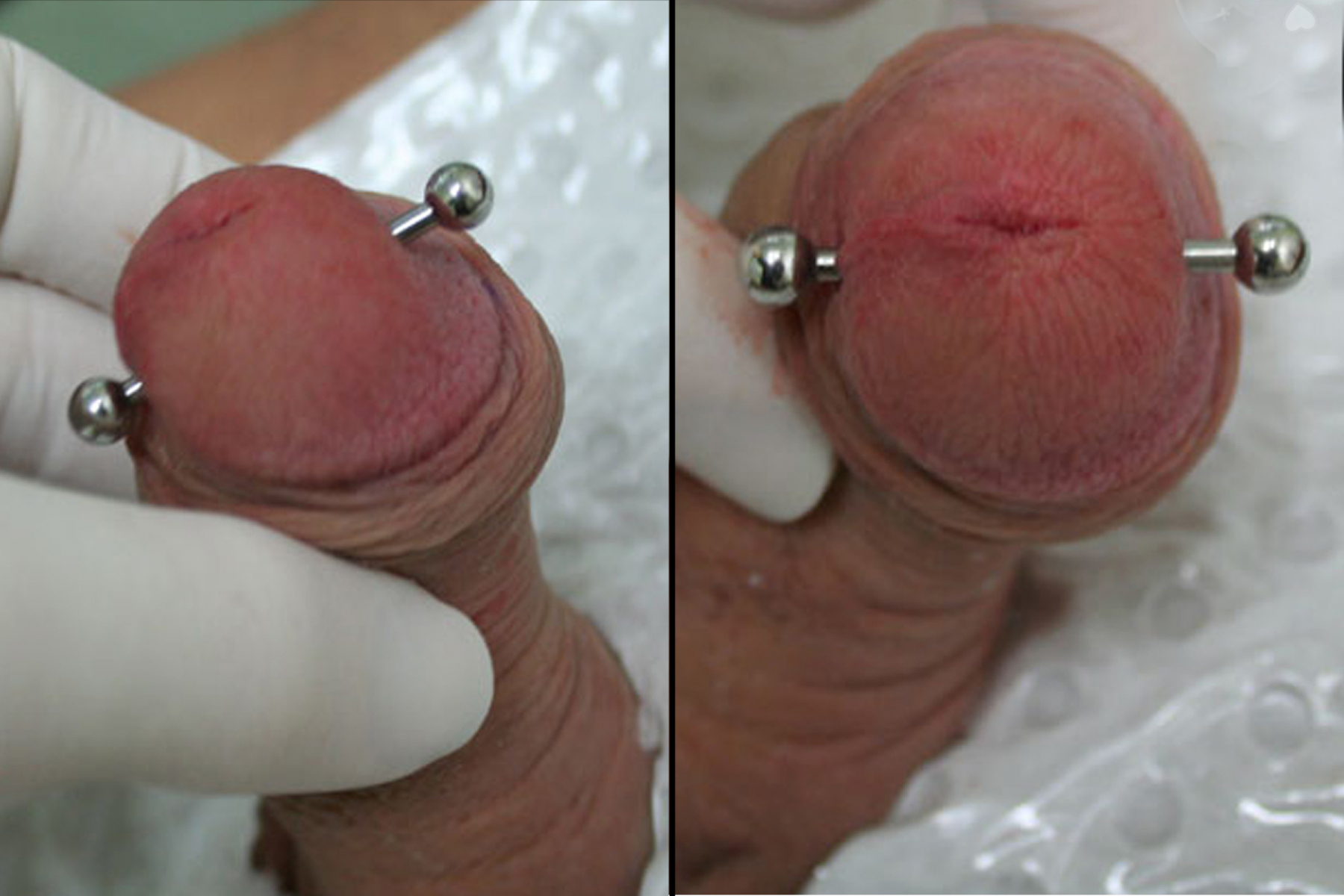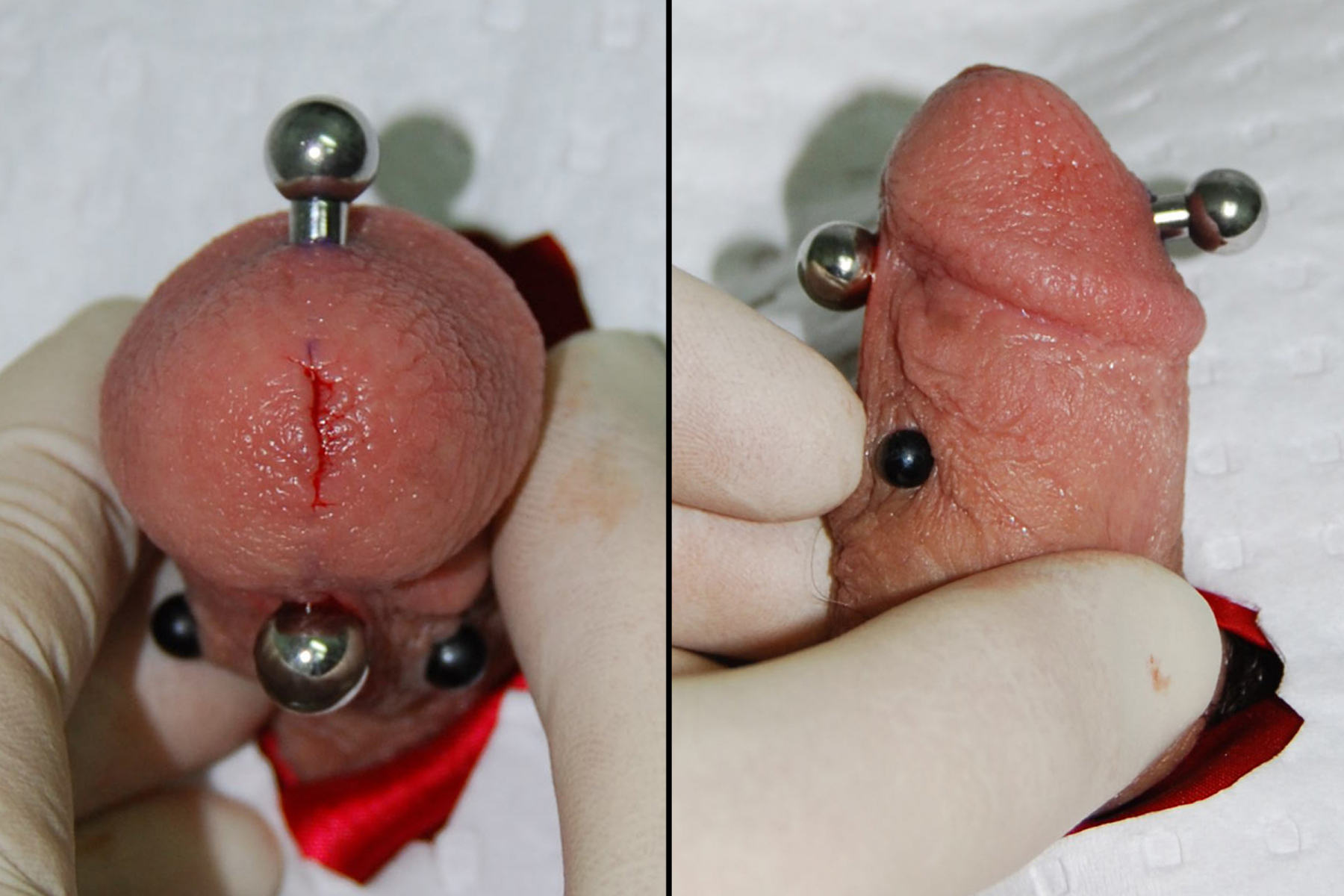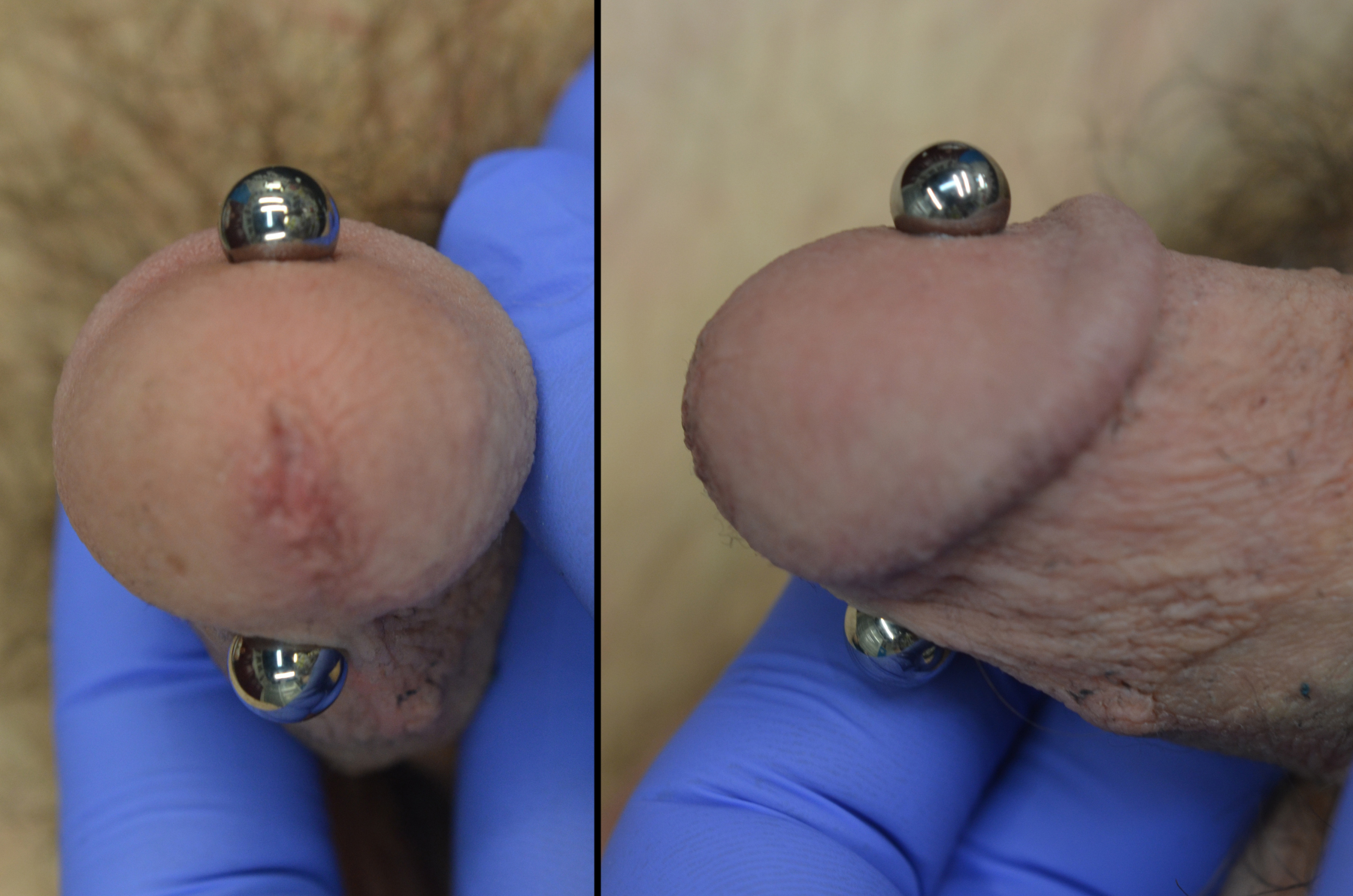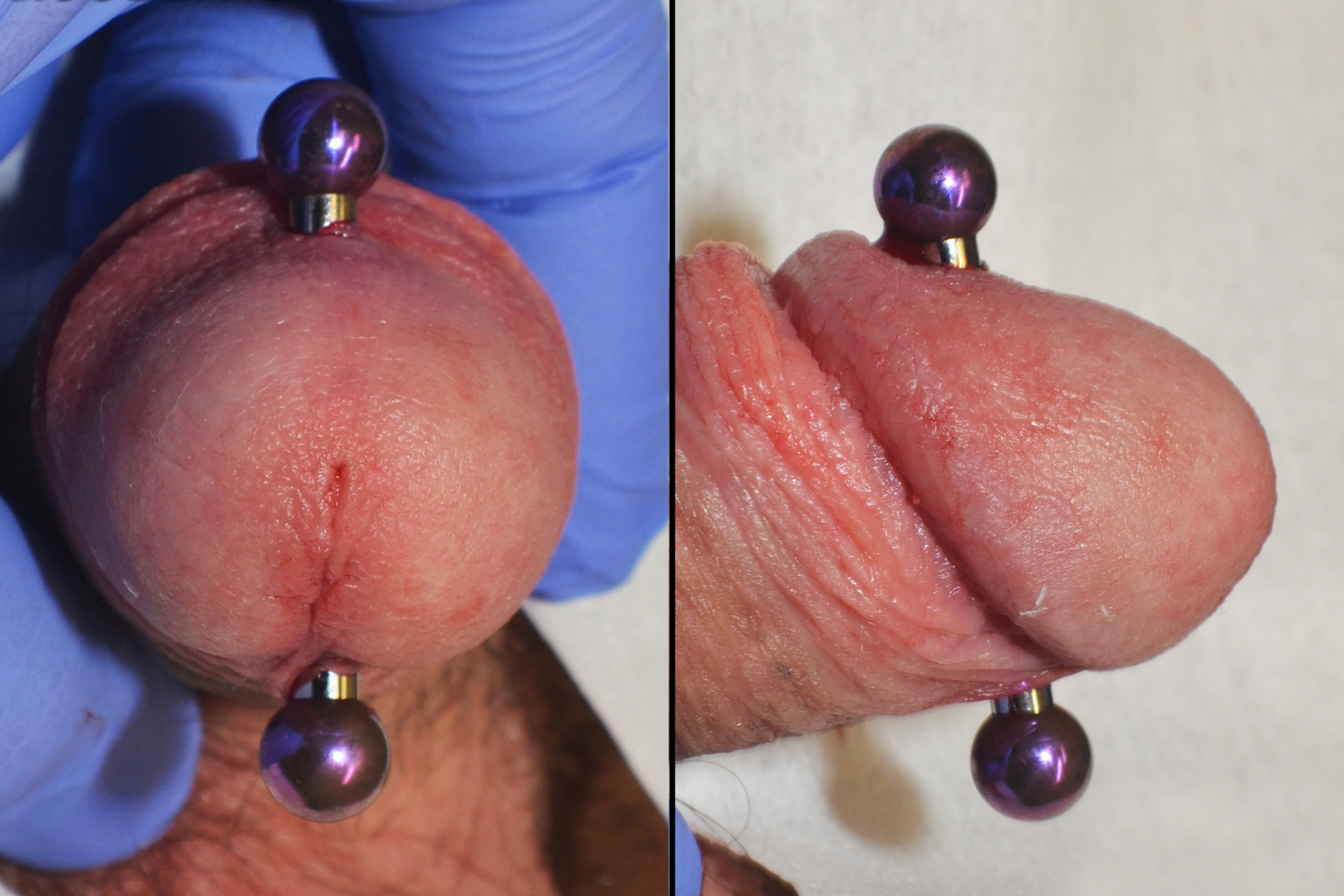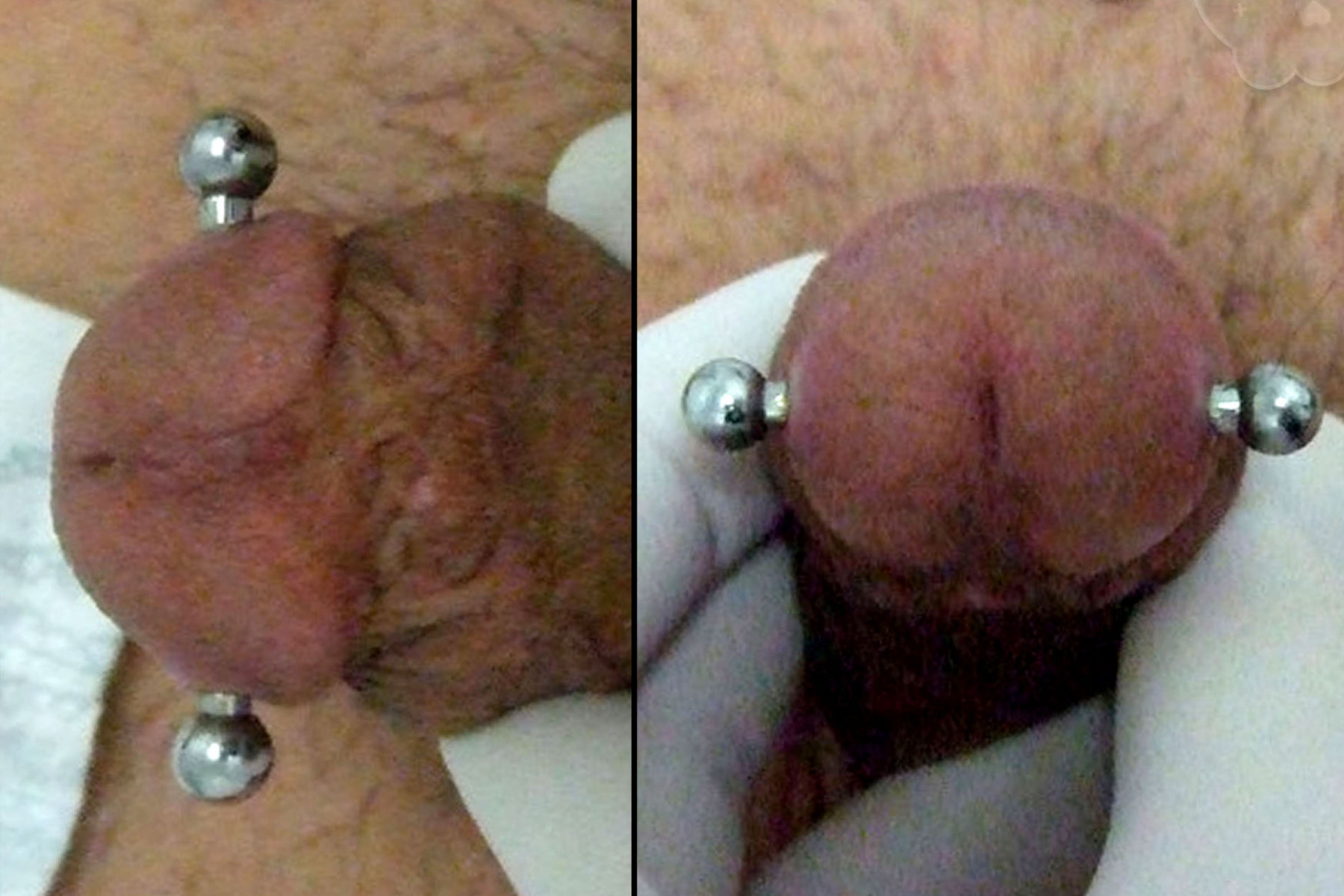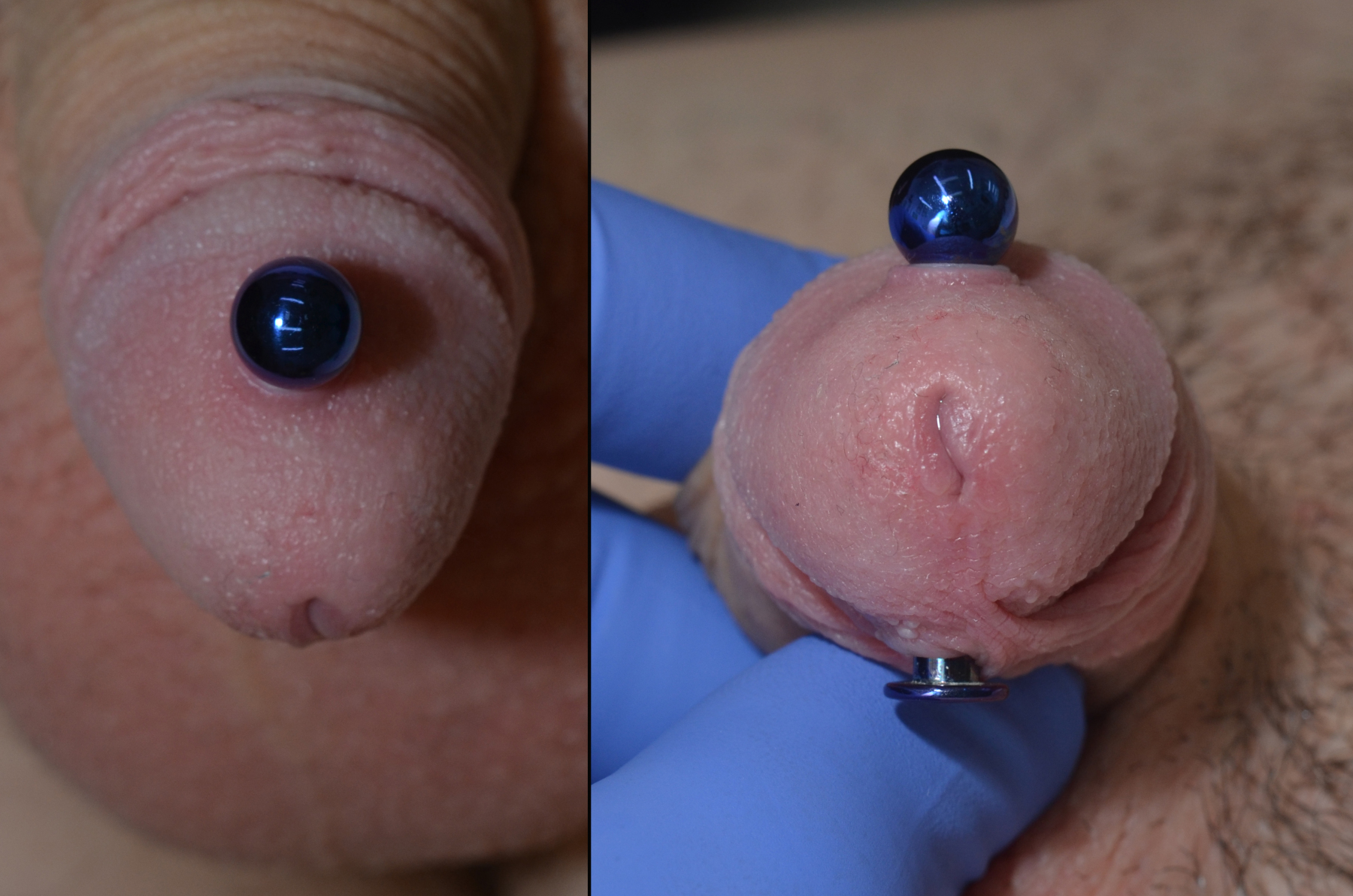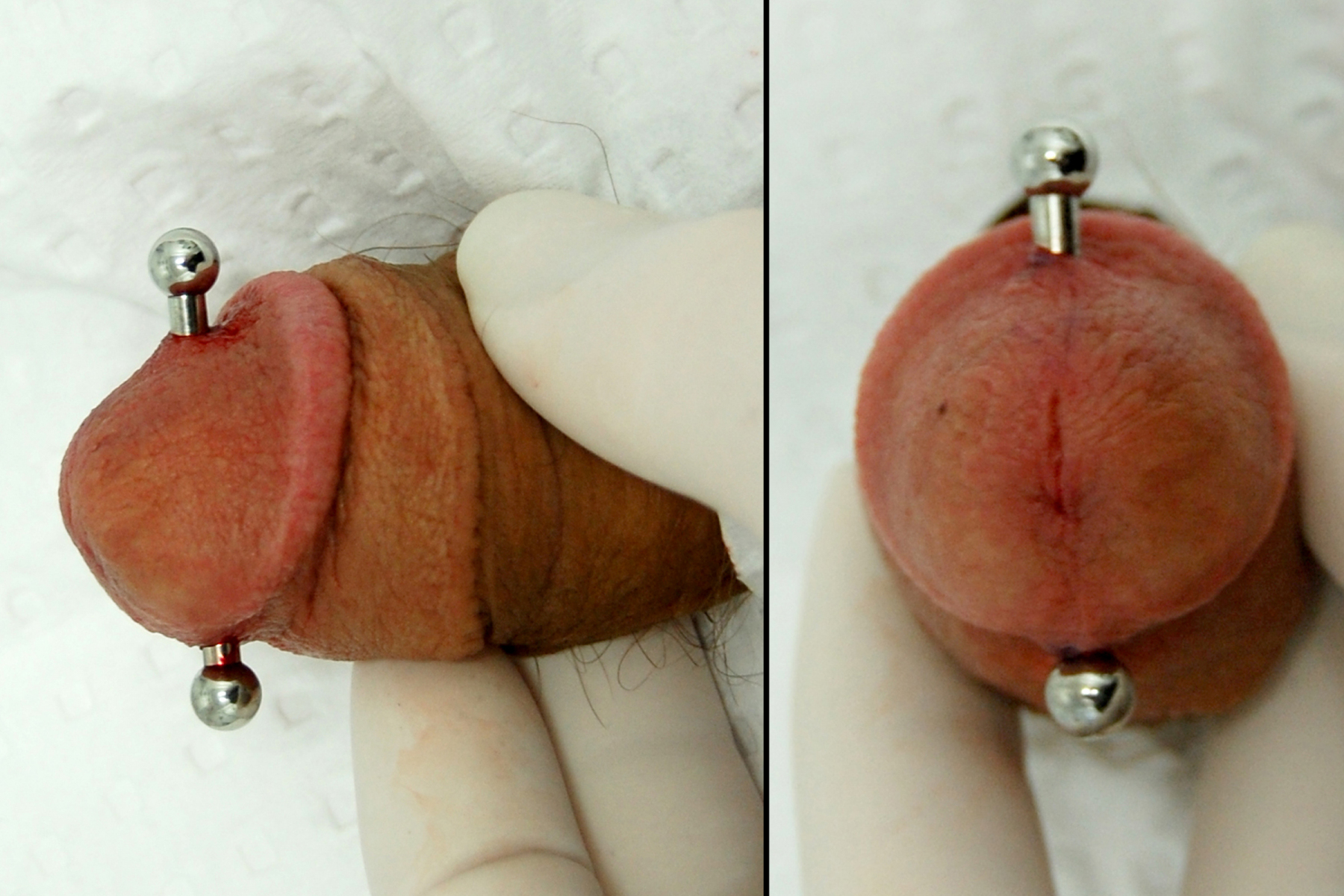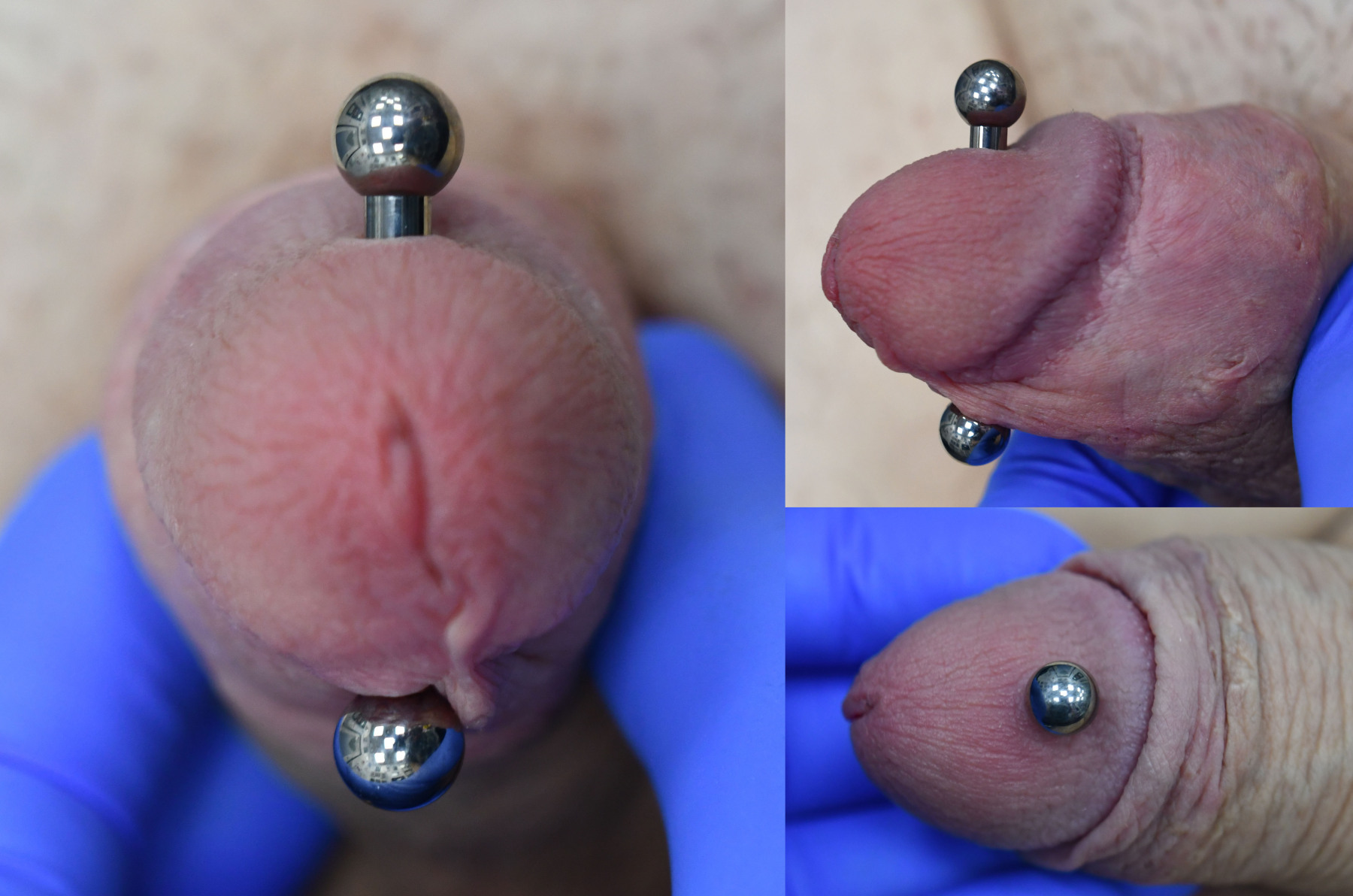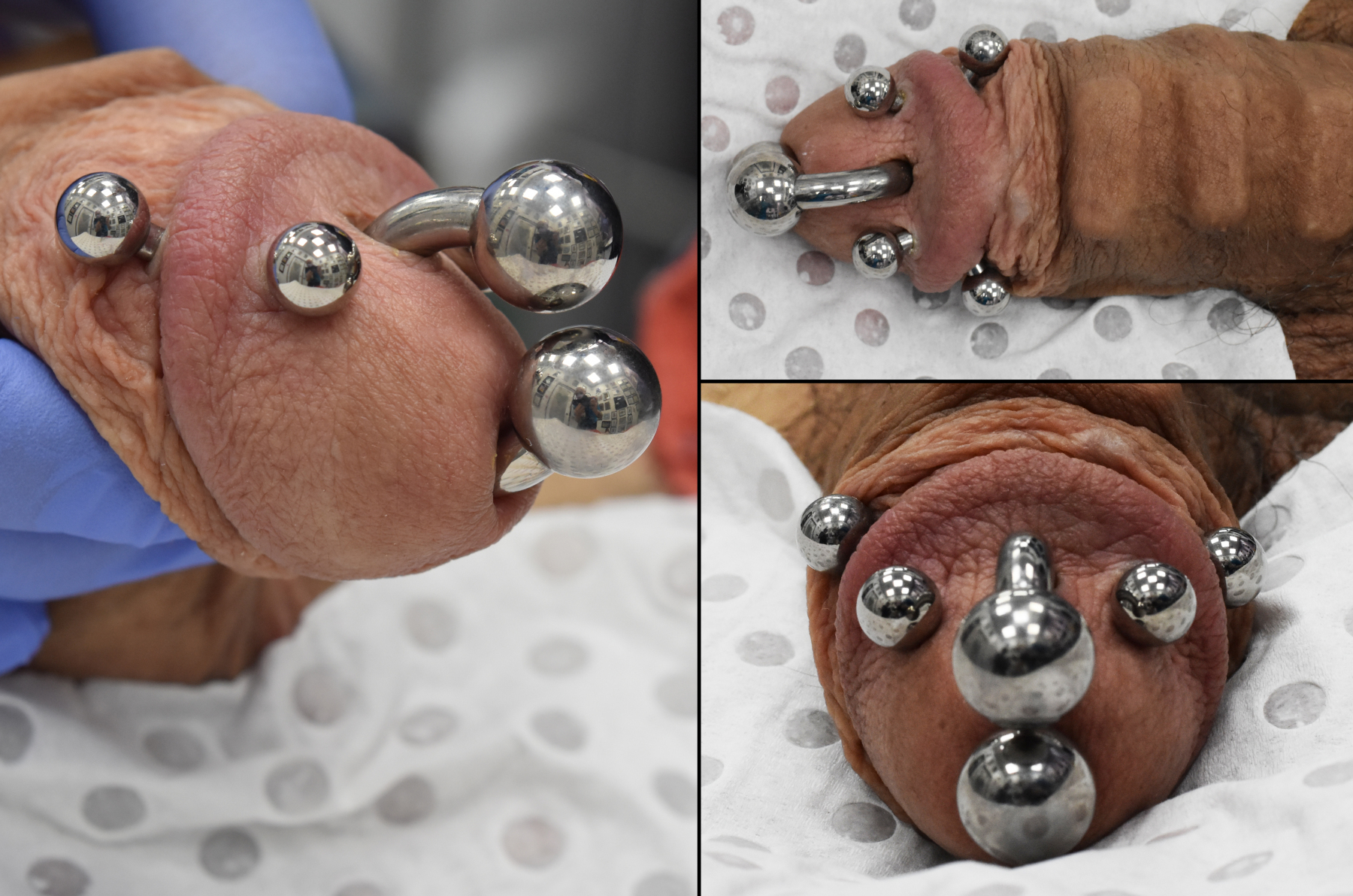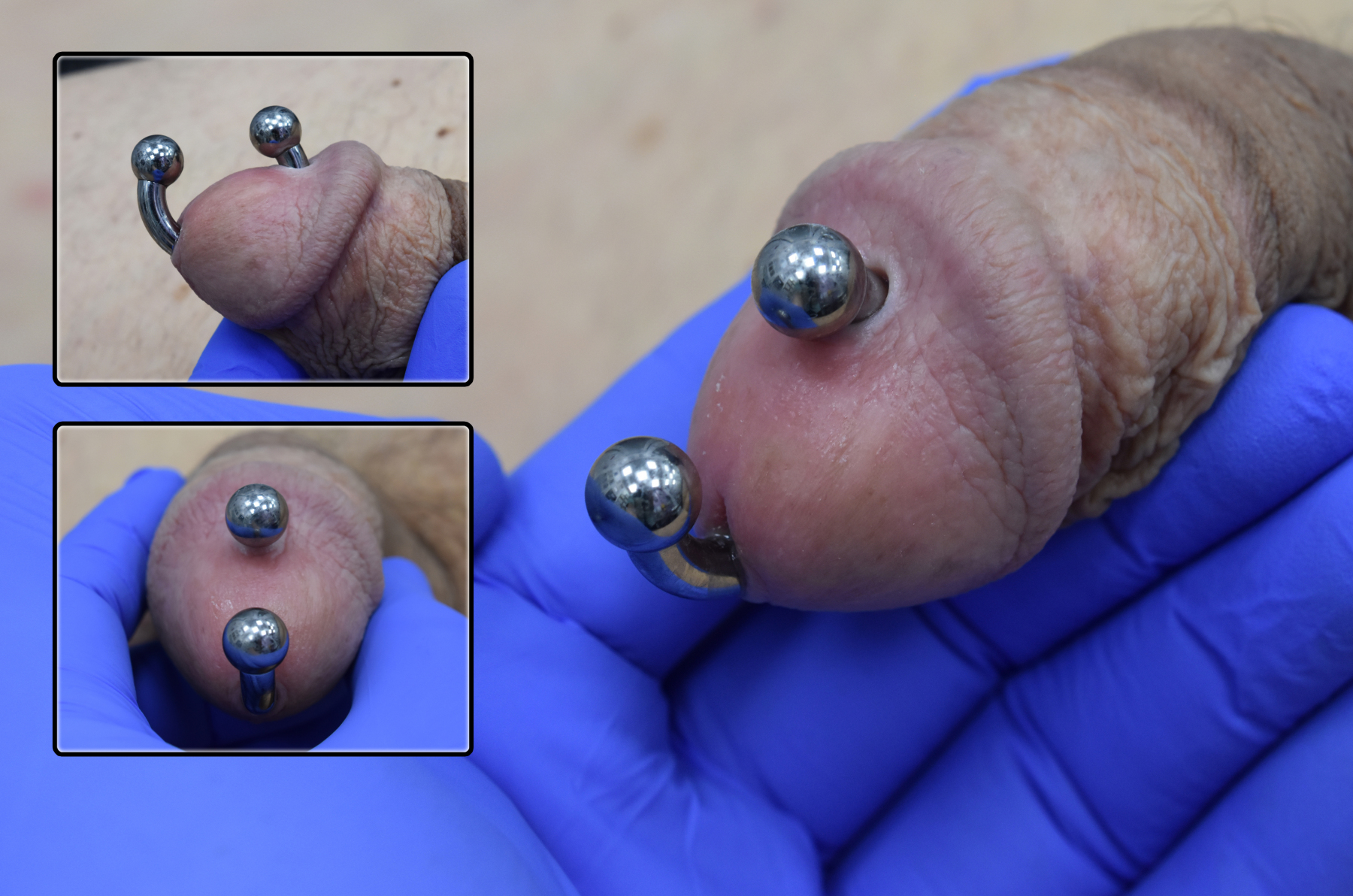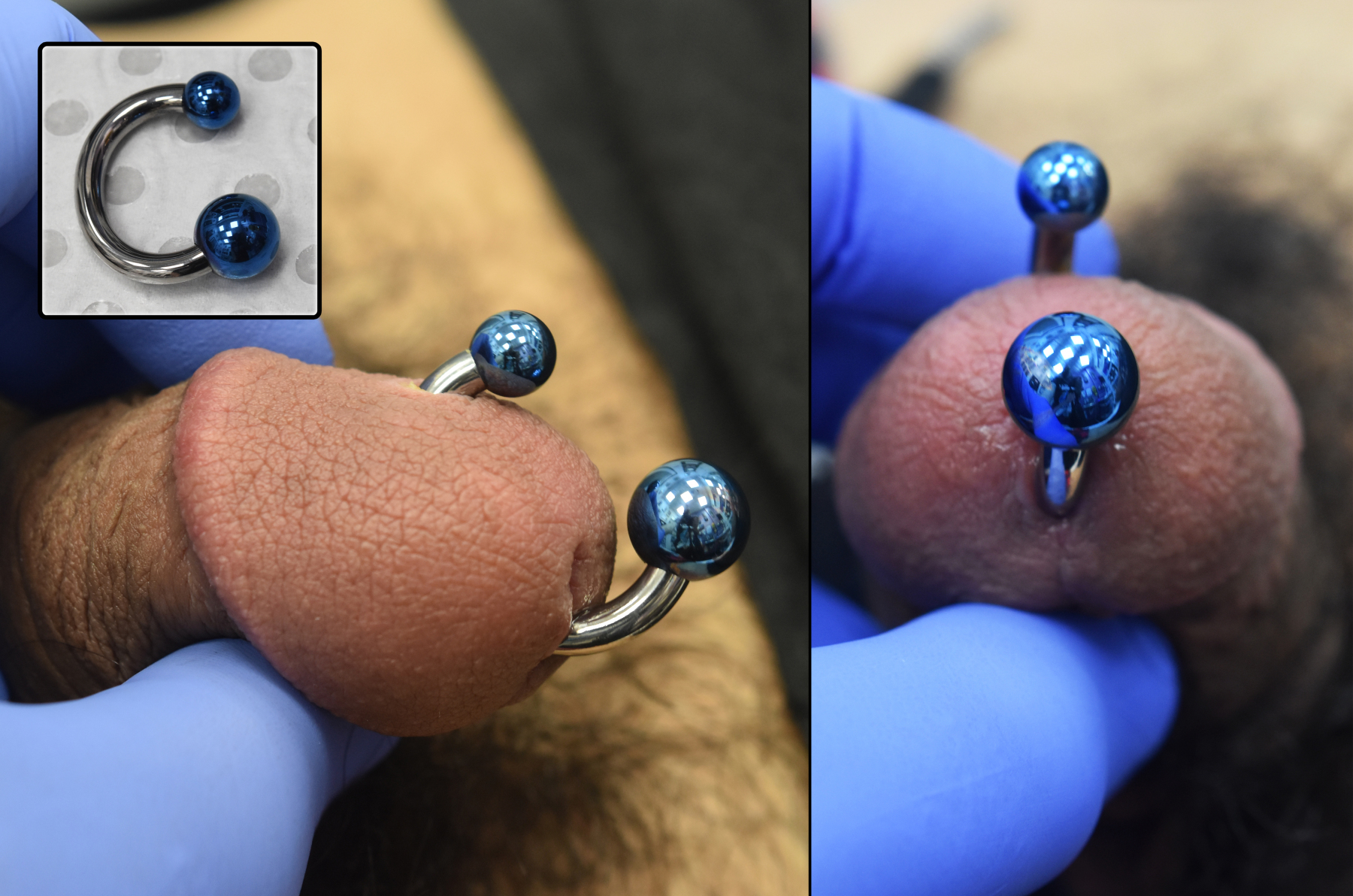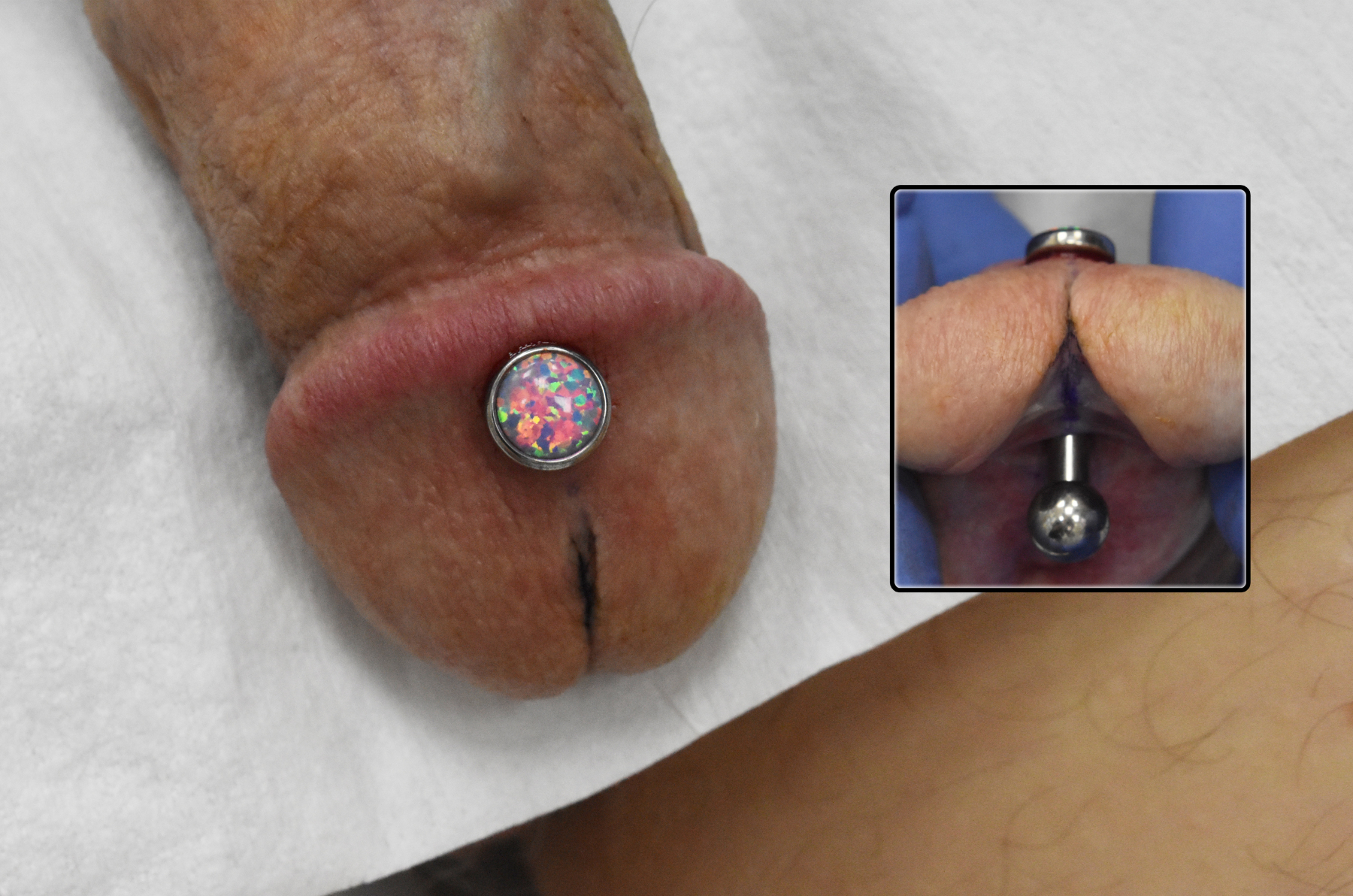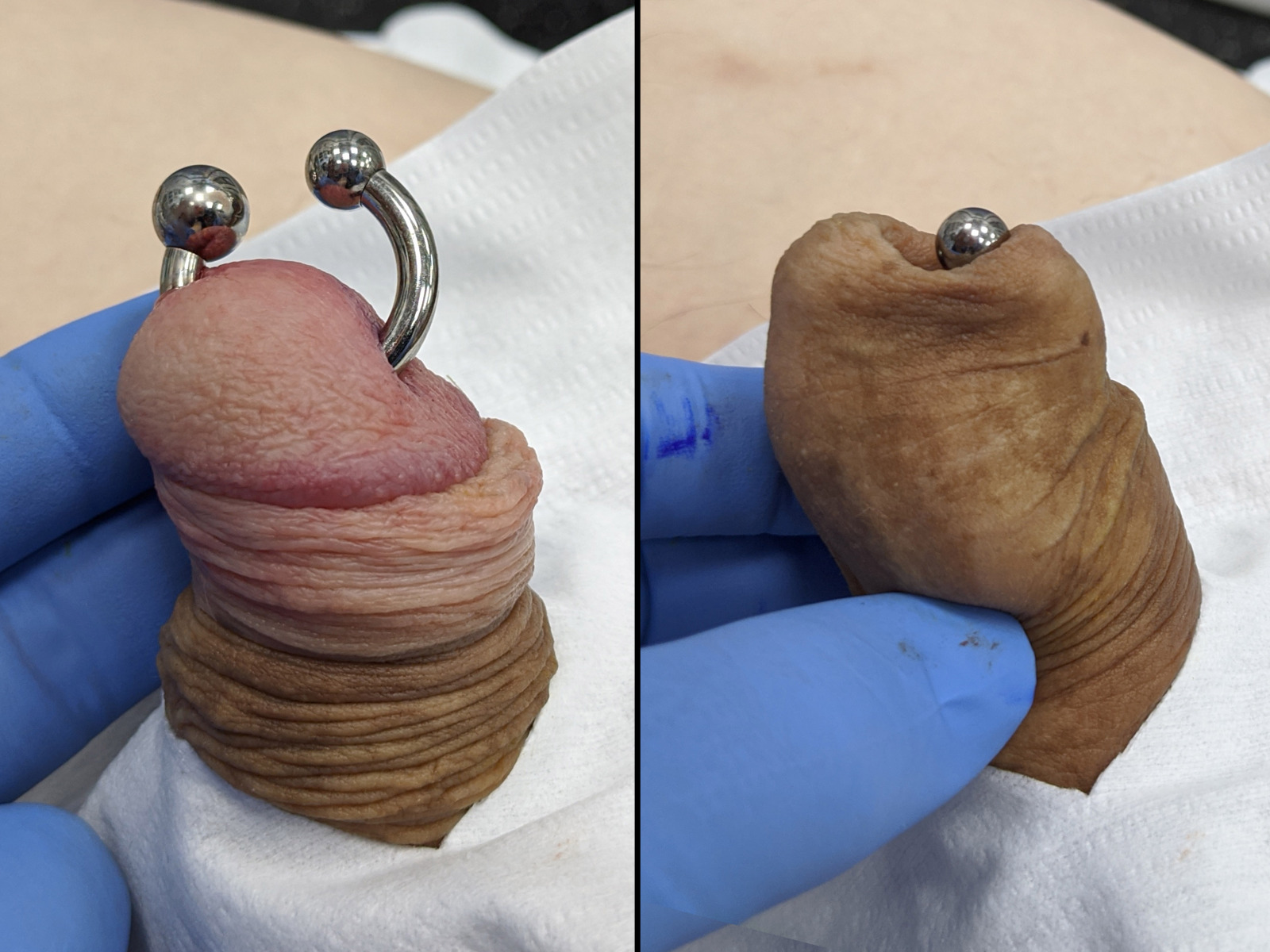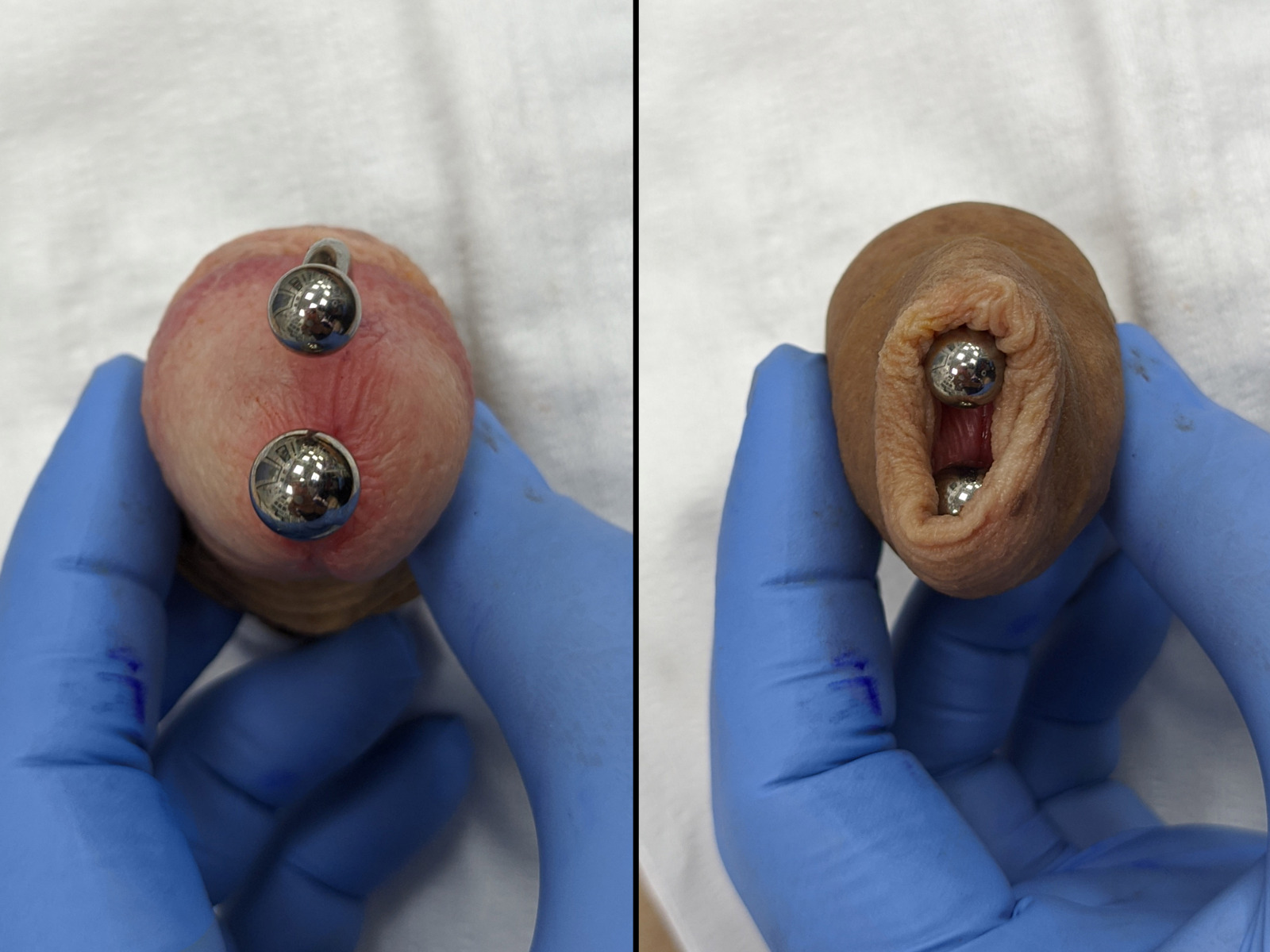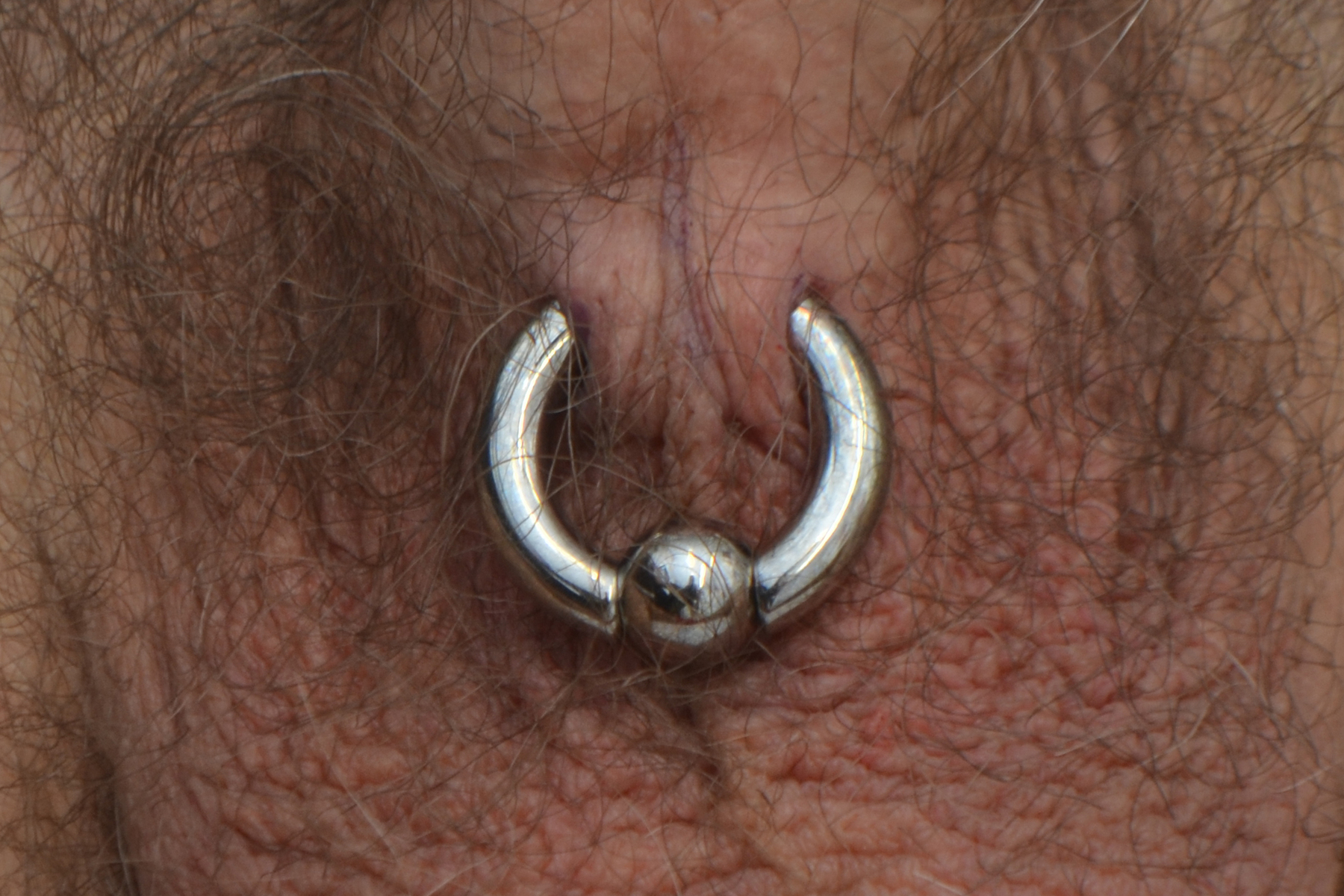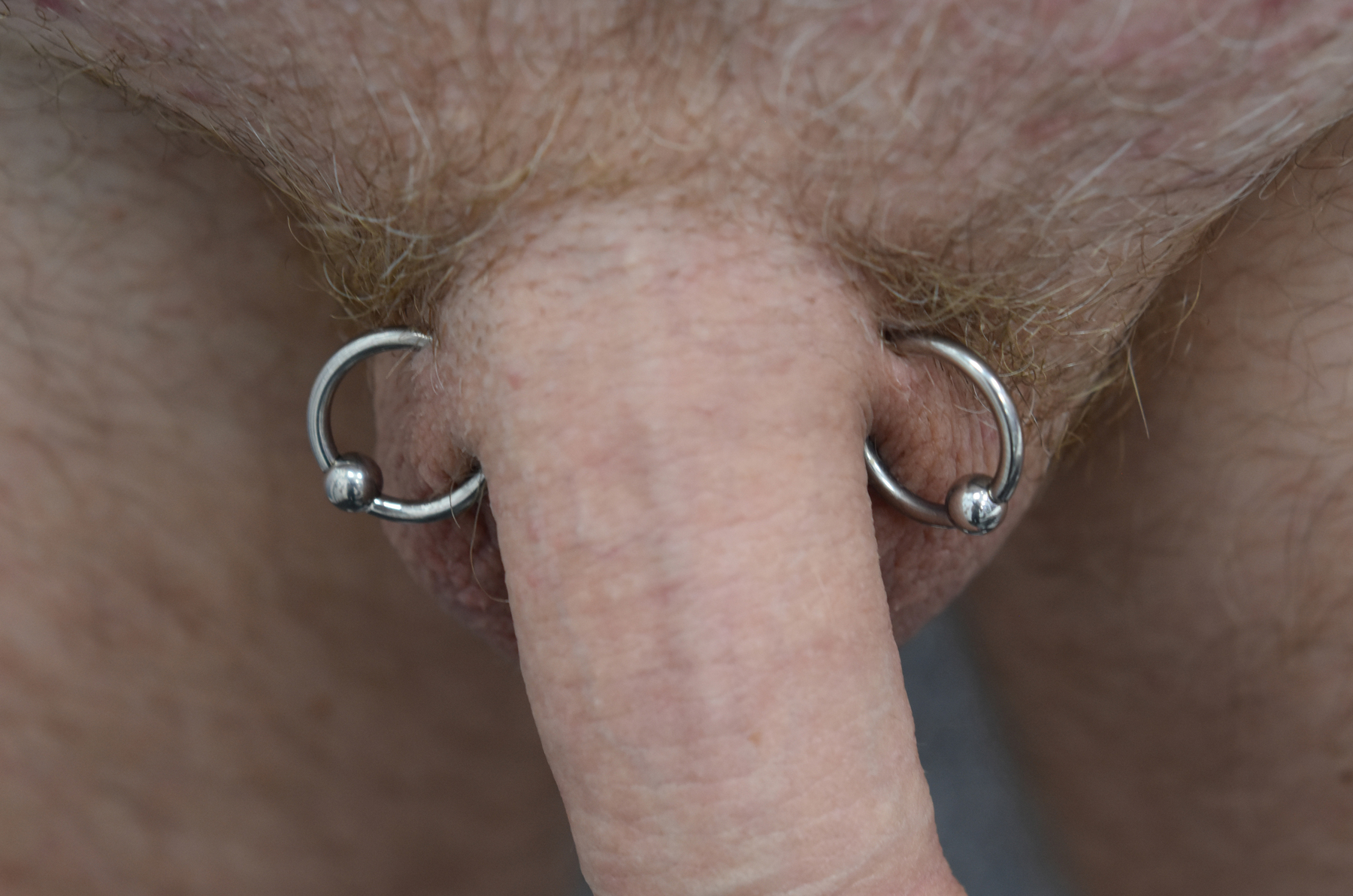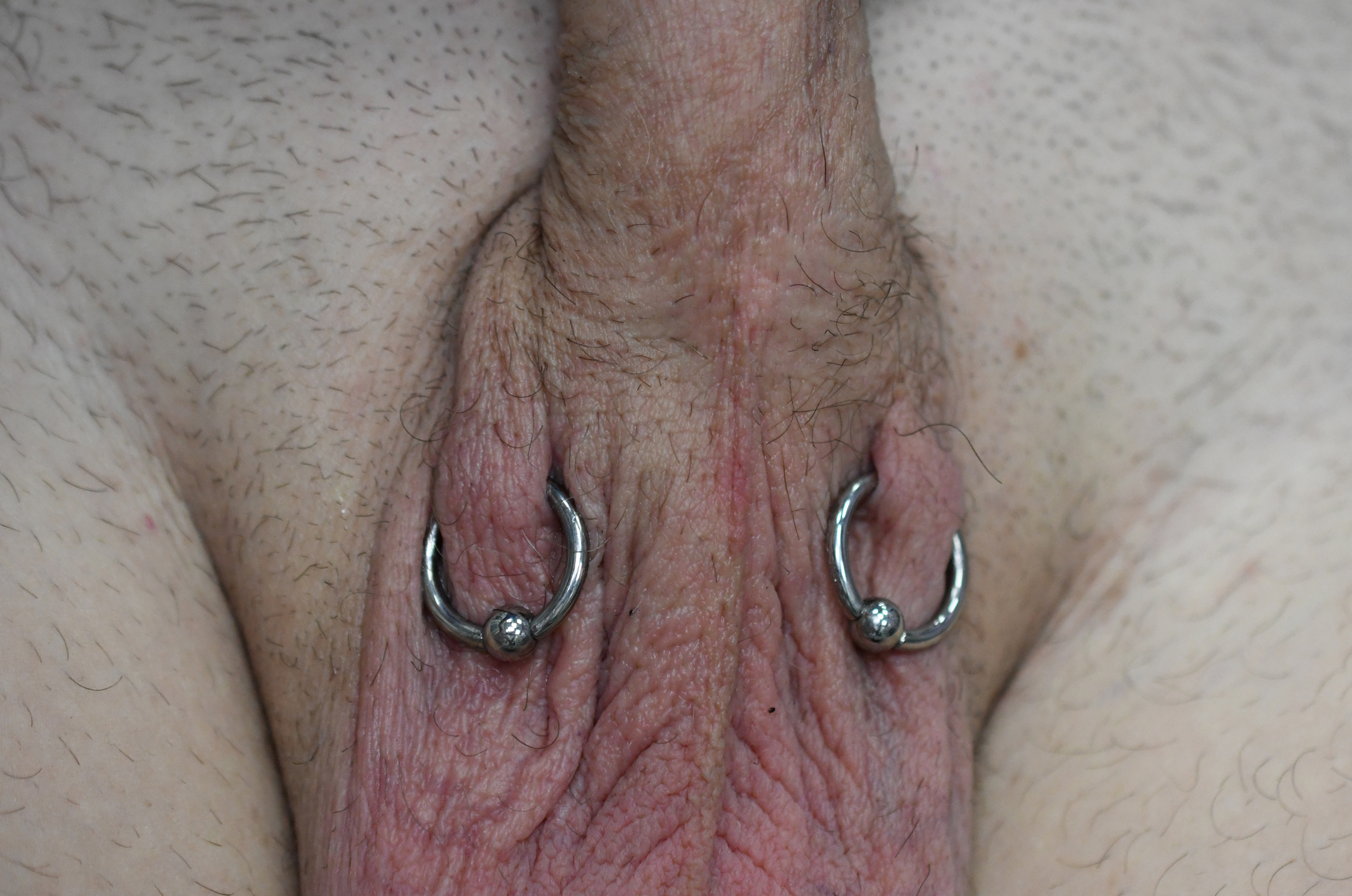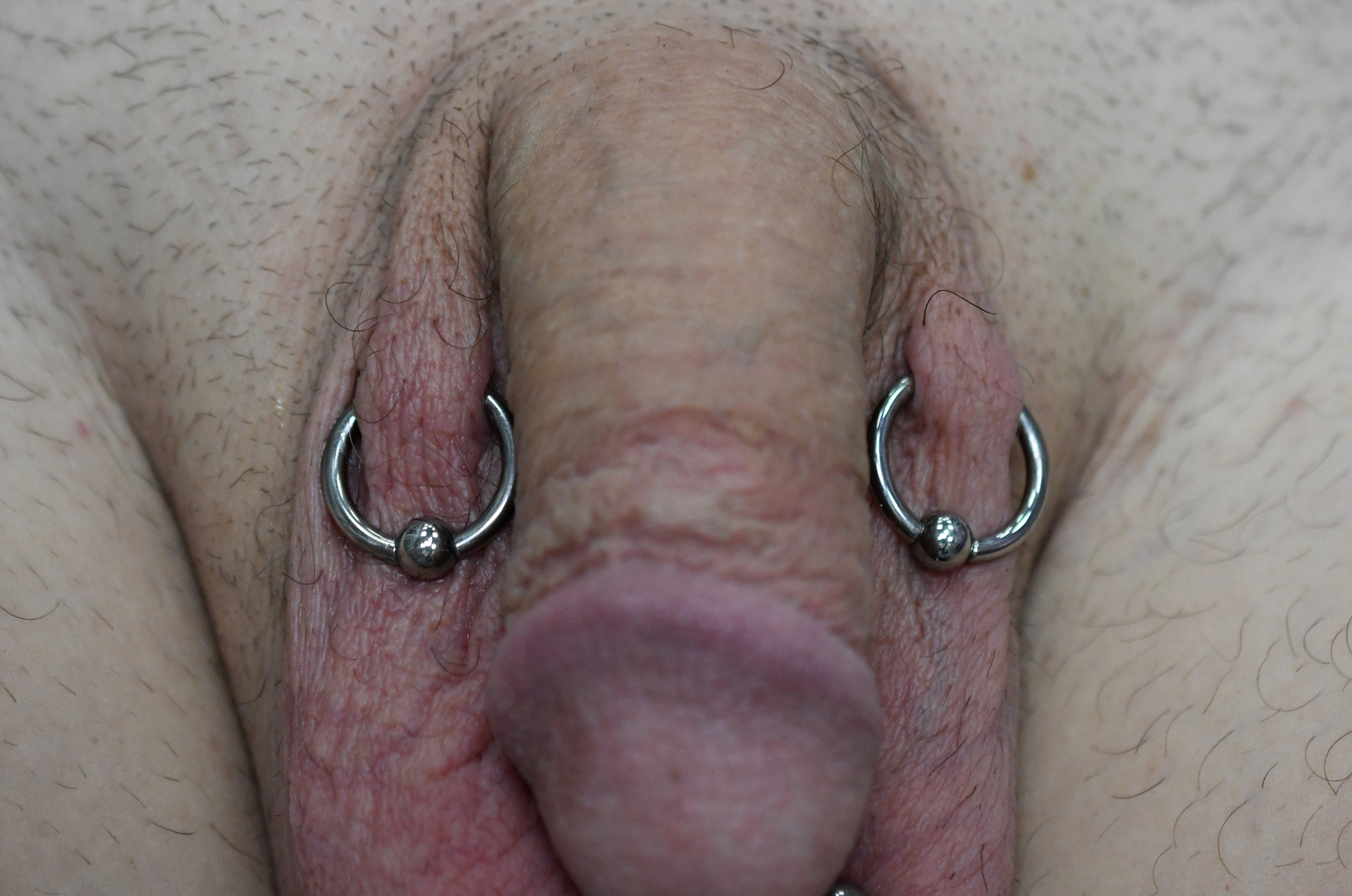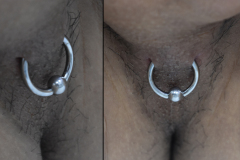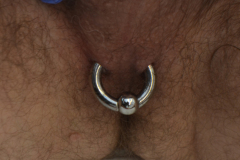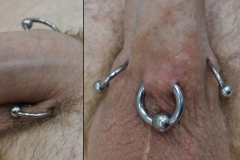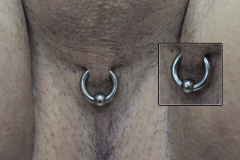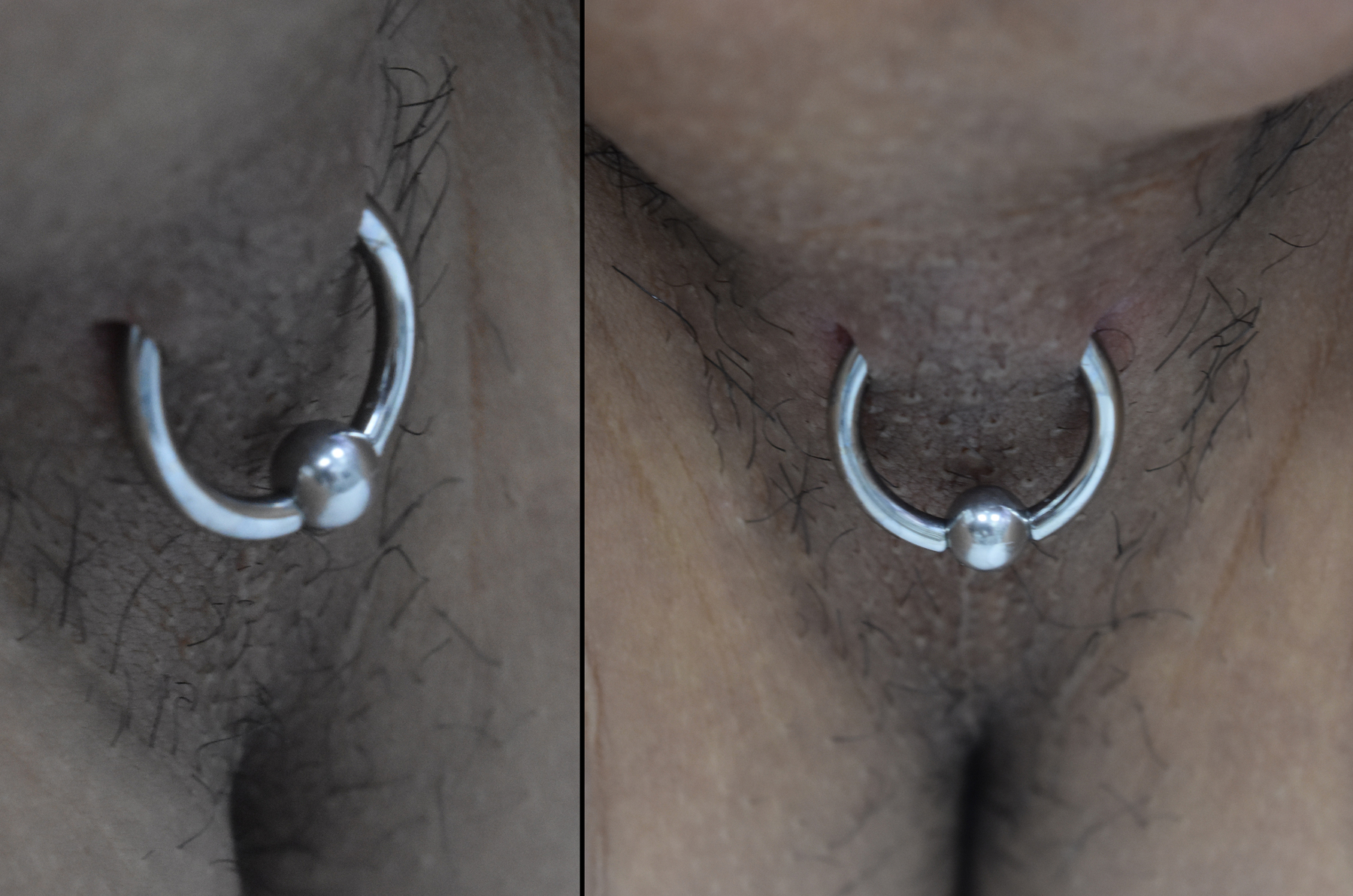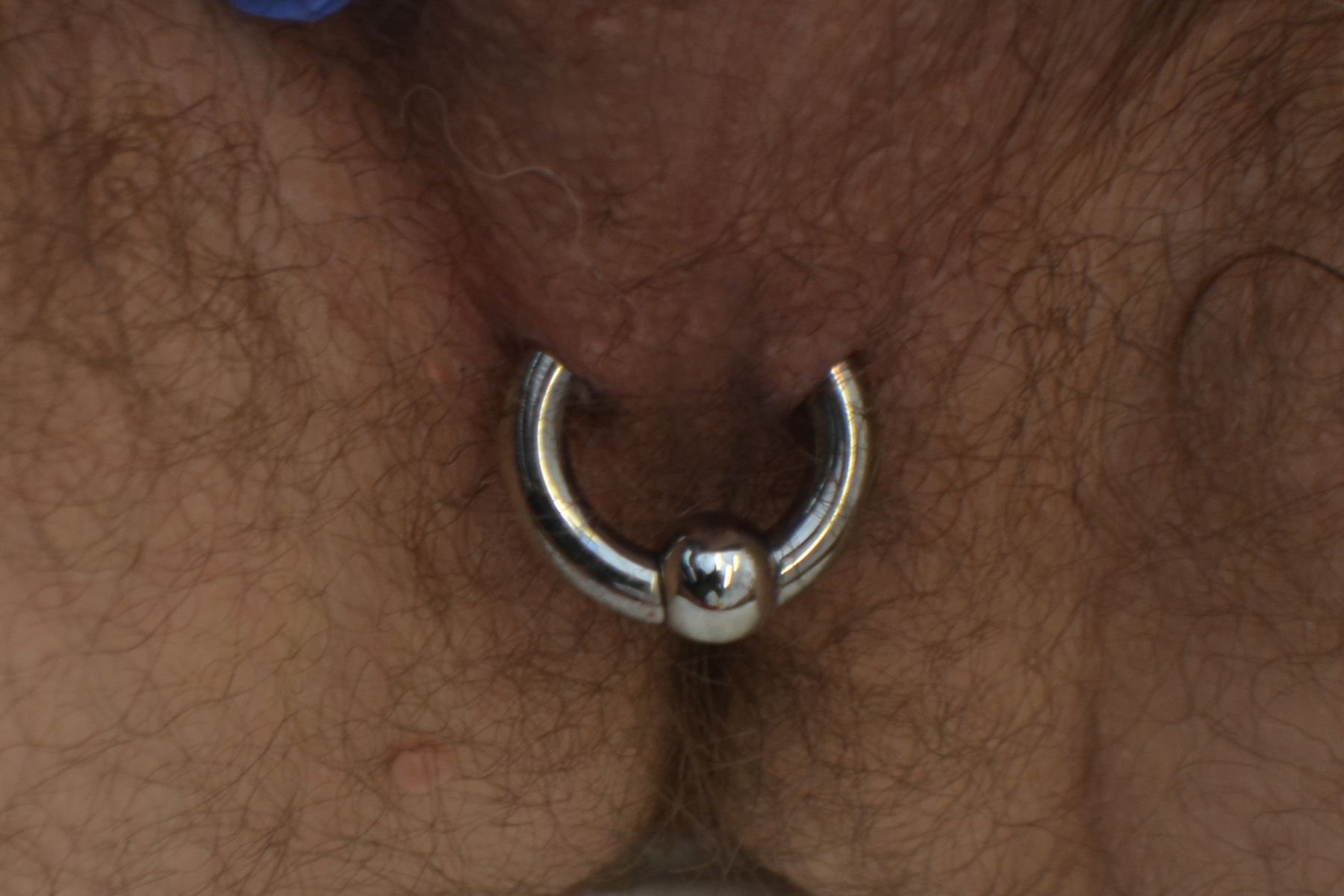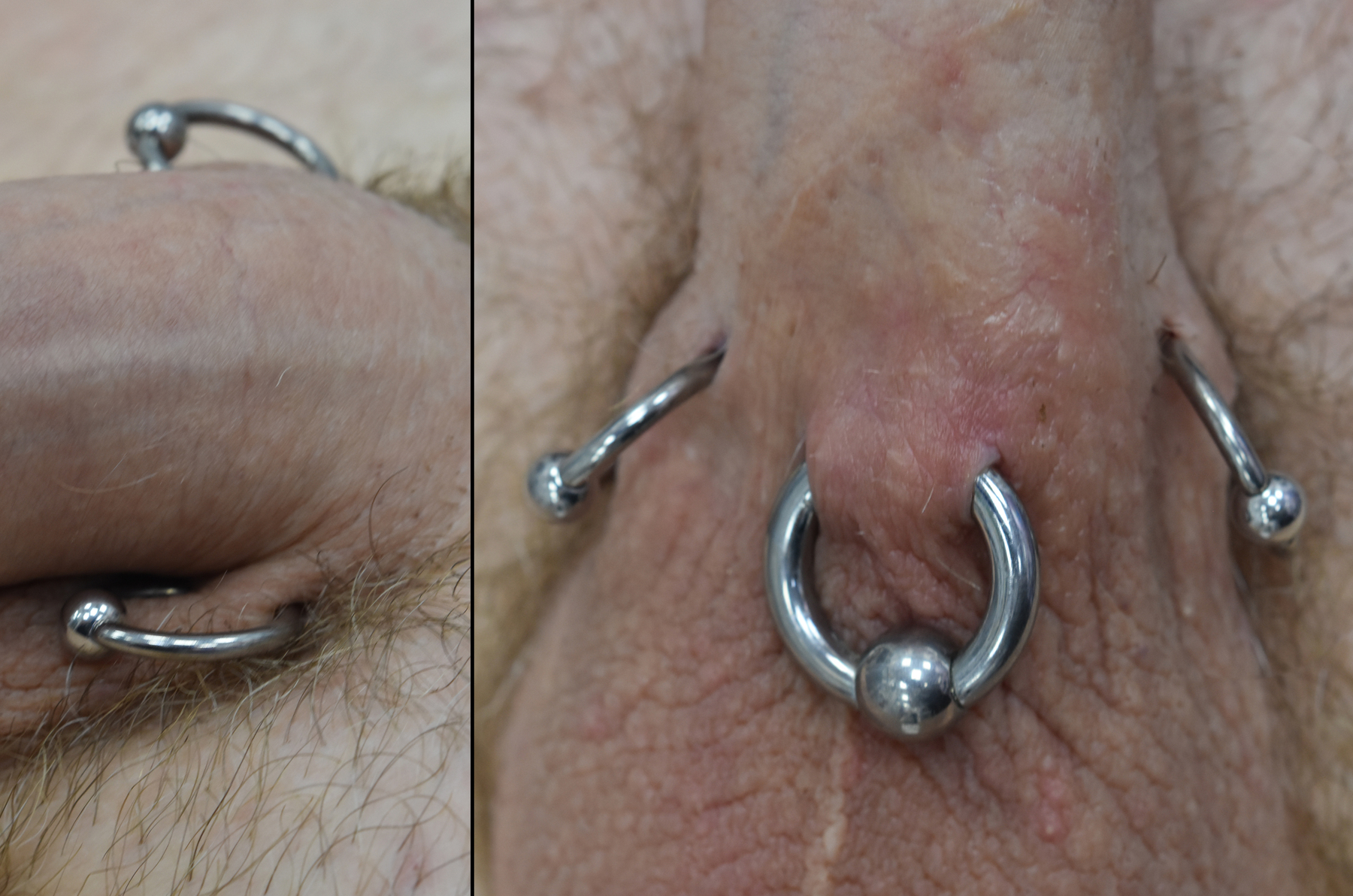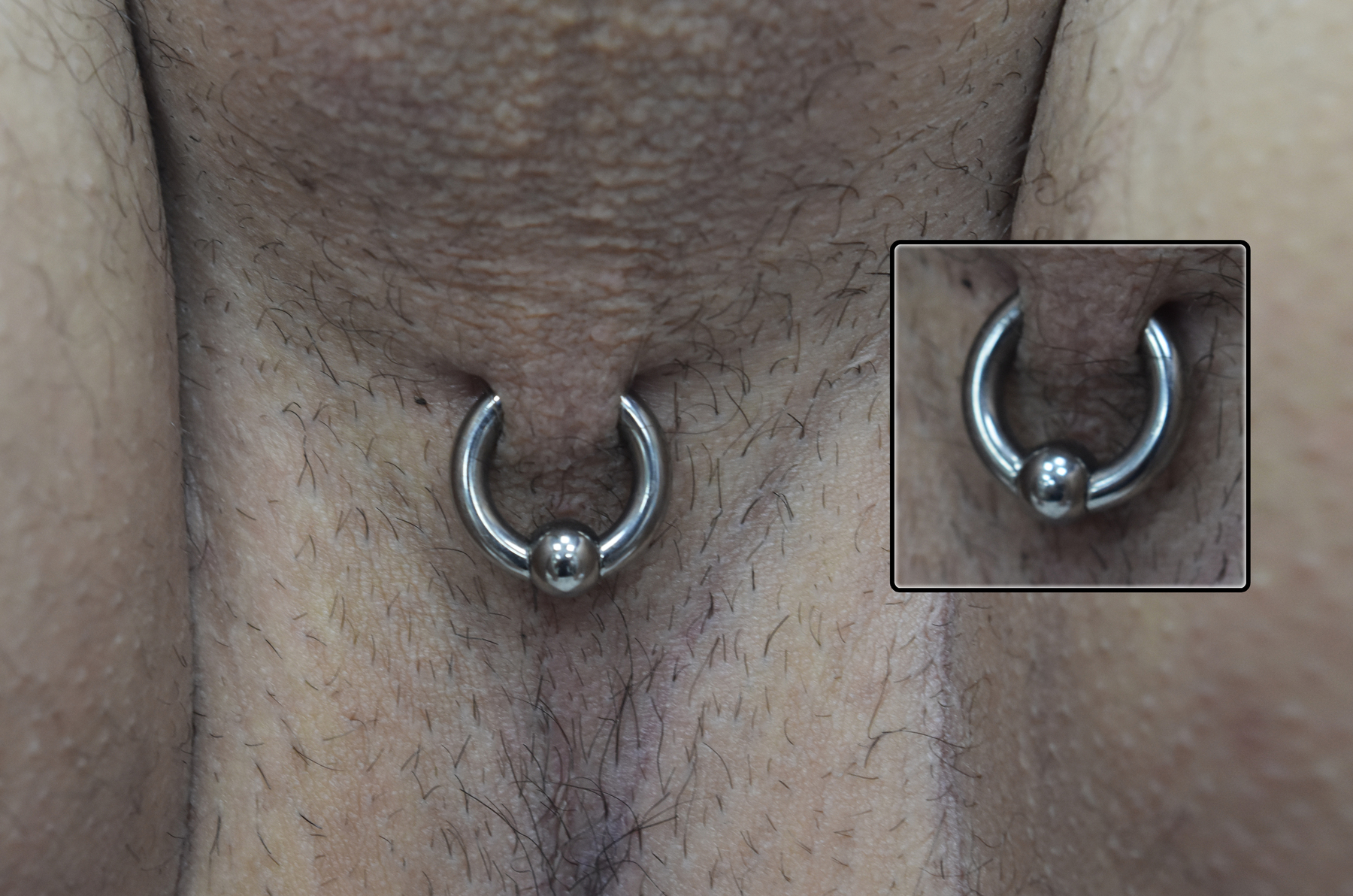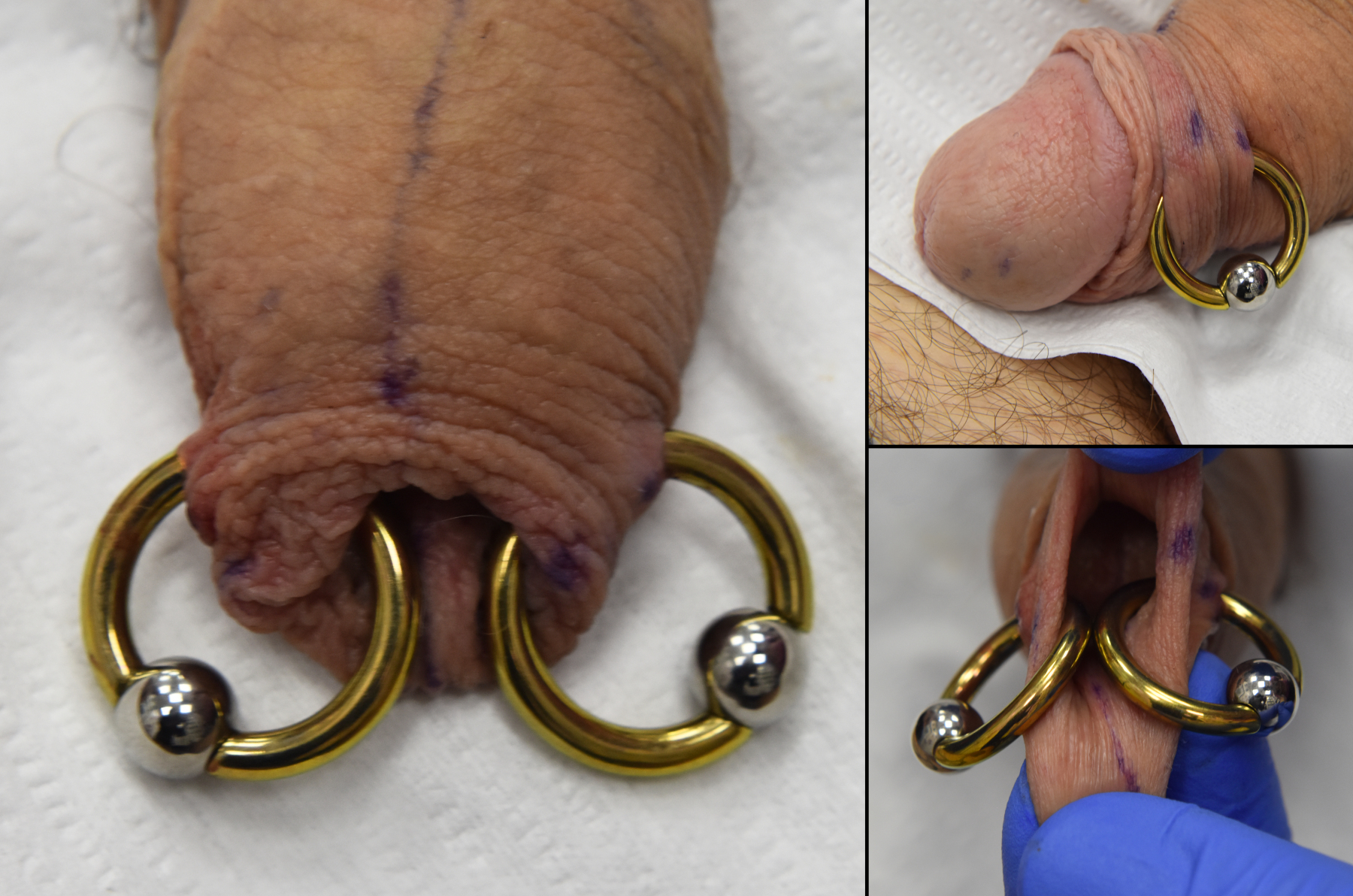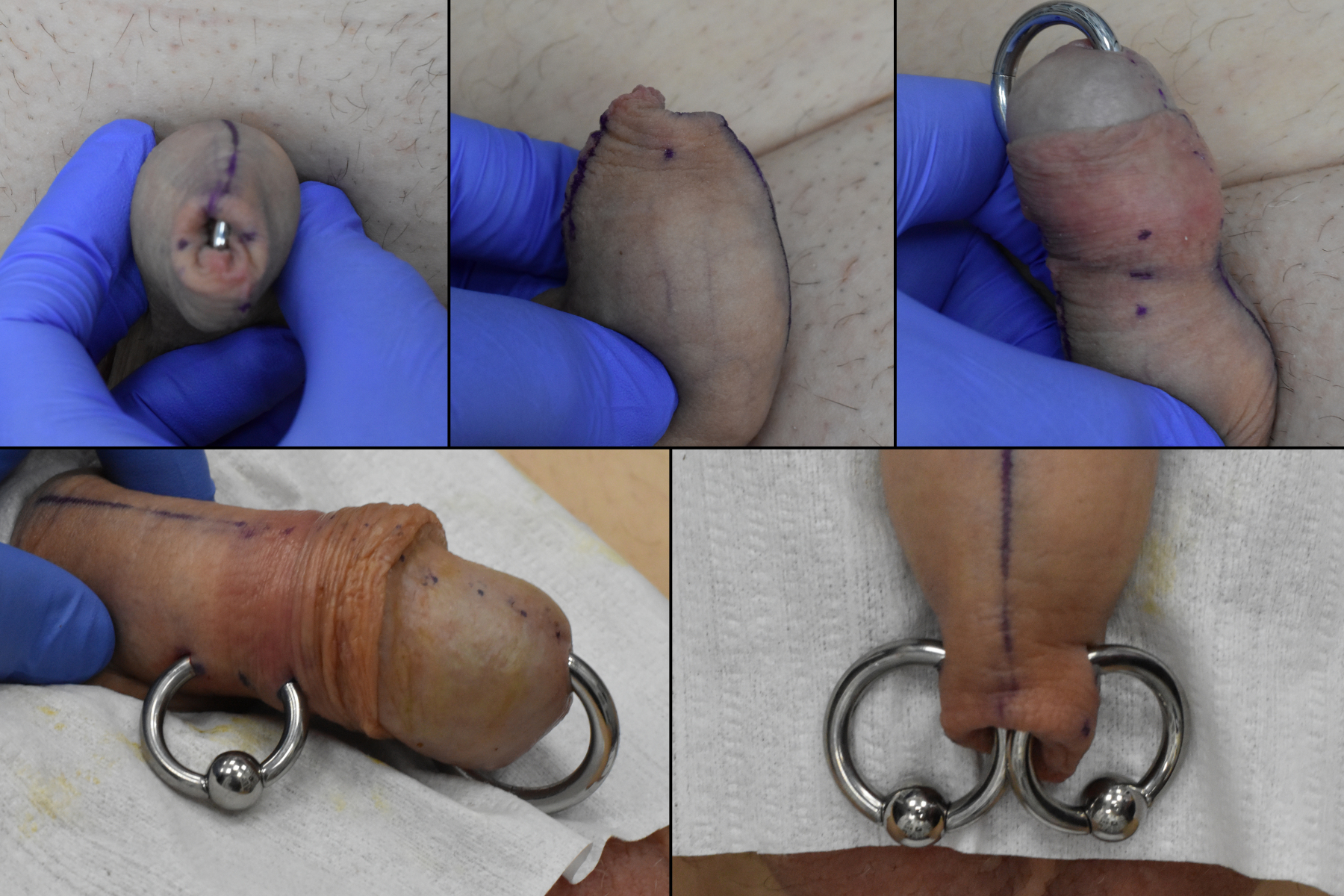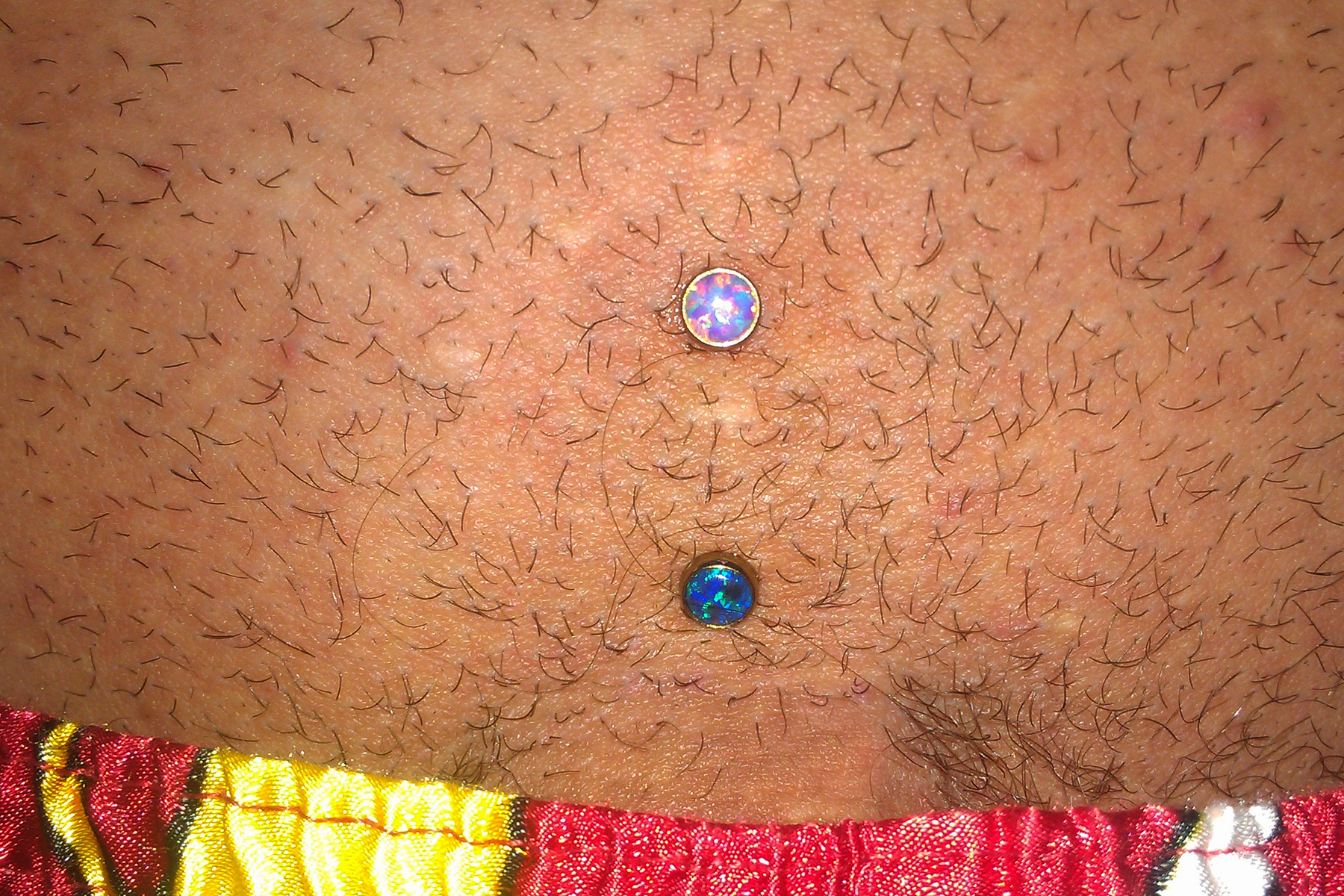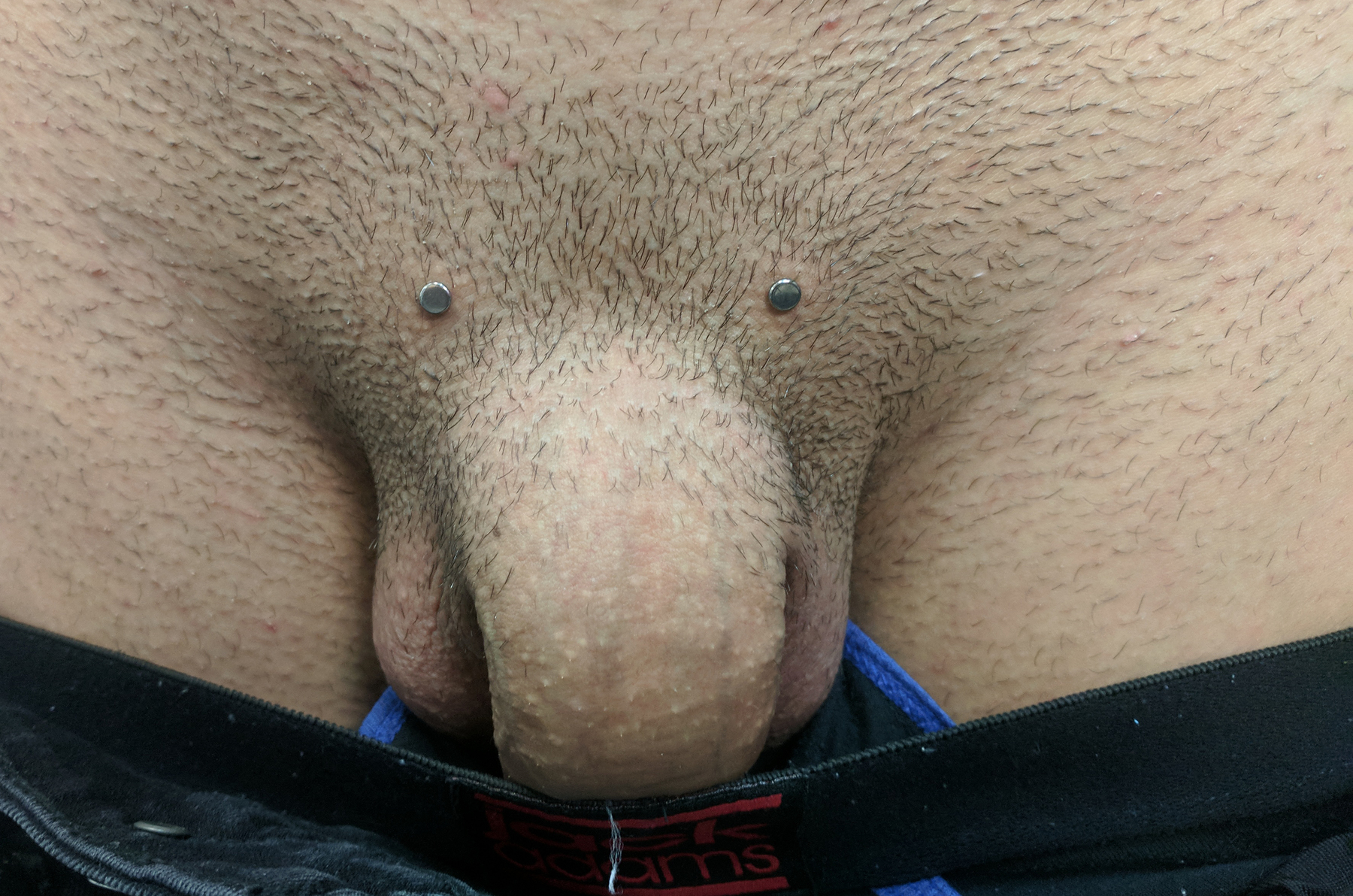Prince Albert (PA)
PA (prince albert) piercings are the most popular male genital piercing as they heal fast, look great, are not overly painful to get done and heal very fast.
They offer both the wearer and partner an increase in sensation and although curved bars can be worn, rings are generally more comfortable. Stretching of the PA occurs naturally during healing and larger jewellery can be inserted once settled.
As it is a transurethral piercing (enters through the urethra), sitting down to urinate is generally suggested for the initial healing period
| PAIN | Medium |
|---|---|
| INITIAL HEALING | 3-4 months |
| AGE REQUIREMENT | 18+ |
| MATURATION | 12+ months |
| TIME BEFORE STRETCHING | 6+ months |
| JEWELLERY | Circular or captive rings (6g+) |
Frenum
Frenum piercings are traditionally placed just behind the glands of the head, through the webbing of the foreskin, which connects to the shaft. They are anatomical piercings, meaning you need the proper structure for them to work, but they can work on intact and circumcised anatomy.
Straight barbells are suggested for the healing and often require downsizing once healed. Rings can also be comfortably worn both under (hanging) and over (larger ring, resting behind the head)
Non-traditional placements are also possible (downwards the shaft, on the top or bottom). However, they are not as easy to heal and often suffer from migration over time.
As they do not pass through the urethra, the urinary stream is unaffected by the piercing, and healing is relatively easy due to the small amount of tissue passed through.
| PAIN | Medium |
|---|---|
| INITIAL HEALING | 2-3 months |
| AGE REQUIREMENT | 18+ |
| MATURATION | 6-9+ months |
| TIME BEFORE RINGS | 12+ months |
| JEWELLERY | Straight barbells (10g+) |
Ampallang and Apadravya
Ampallang’s (side to side), and Apadravya’s (top to bottom) piercings both go directly through the head of the penis, passing through the urethra.
They can be performed on intact anatomy (with a foreskin); however, healing can be significantly extended due to the increased pressure.
Due to the amount of tissue passed through require a little more dedication than other piercings to heal; however, they are considered quite rewarding for both the wearer and partner.
Downsizing is highly encouraged during the healing process to ensure a snug fit when fully erect. Often, measuring yourself at home is advised to determine the excess when engorged. Although technically both an Ampallang and an Apadravya could be worn together, picking just one is advised.
As they are transurethral piercings (enter through the urethra), sitting down to urinate is generally suggested for the initial healing period.
| PAIN | HIGH-VERY HIGH |
|---|---|
| INITIAL HEALING | 6-9 months |
| AGE REQUIREMENT | 18+ |
| MATURATION | 18+ months |
| TIME BEFORE STRETCHING | 12+ months |
| JEWELLERY | Straight barbells (6g+) |
Reverse Prince Albert (RPA)
Although the RPA (Reverse Prince Albert) shares a name similar to the PA (Prince Albert), they differ dramatically regarding getting pierced and healing.
Pain and healing times increase accordingly as it passes through significantly more tissue. Rings are often worn in them during the healing (most commonly an open-up circular barbell), and then changed to a closed ring once healed for comfort.
As it is a transurethral piercing (enters through the urethra), sitting down to urinate is generally suggested for the initial healing period. Be careful of your toilet seat when standing up, as contamination and snagging can easily occur.
| PAIN | High |
|---|---|
| INITIAL HEALING | 6-9 months |
| AGE REQUIREMENT | 18+ |
| MATURATION | 12+ months |
| JEWELLERY | Circular and captive rings (6g+) |
Scrotal
Scrotal piercings are generally placed down the centre line of the scrotum, singularly or in pairs.
As they are considered a ‘surface piercing’, healing can take several months, and keeping the area dry while healing is suggested. They can be done anywhere from where the scrotum meets the shaft (lorum) or to the rear towards the perineum (guiche).
Rings are suggested for healing; however, barbells can be comfortably worn once healed.
| PAIN | LOW-Medium |
|---|---|
| INITIAL HEALING | 4-8+ months |
| AGE REQUIREMENT | 18+ |
| MATURATION | 9+ months |
| TIME BEFORE STRETCHING | 6+ months |
| JEWELLERY | Captive rings (10g+) |
Guiche
Horizontally across the raphé (midline) of the Perineum (between genitals & anus). They can be performed on someone AFAB, but less tissue is present. Multiples are often possible, but should be done singularly.
Considered pinchy, but not too painful and selected by many for their first penile piercing.
It can be challenging to heal due to pressure, moisture, and movement and may not be suitable for all anatomy types or those with active lifestyles.
| PAIN | LOW-Medium |
|---|---|
| INITIAL HEALING | 4-8+ months |
| AGE REQUIREMENT | 18+ |
| MATURATION | 9+ months |
| TIME BEFORE STRETCHING | 6+ months |
| JEWELLERY | Captive rings (10g+) |
Foreskin
Depending on personal preference, they can be done singularly, in a pair or in a desired combination (3+9 o’clock or 12+6 o’clock are common pairs).
Origins of foreskin piercings date back to the 1st century when physician Roman Celsus described the procedure in the medical texts “De Medicina”. The Romans also practised infibulation, where two piercings were locked together to prevent sexual intercourse as a form of chastity.
Care must be taken to ensure enough distance between piercings to ensure no pinching, and care is essential during the initial healing period, as the thin tissue is prone to scarring and migration.
| PAIN | Medium-High |
|---|---|
| INITIAL HEALING | 3-6 months |
| AGE REQUIREMENT | 18+ |
| MATURATION | 6-9+ months |
| TIME BEFORE STRETCHING | 12+ months |
| JEWELLERY | Captive rings (10g+) |
Other Penile
If you are considering something a little different, please drop into the studio for a free consultation.
Surface
Although these piercings are often seen in many different areas on the body, they should be placed where there is minimal movement of the tissue to prevent rejection. When placed correctly, they typically settle in quite quickly and are “anchored” in place by tissue growing through the base of the jewellery.
It is important to note that dermal anchors are considered “long-term temporary piercings”, as they are prone to migration and rejection. However, with proper placement, jewellery and aftercare, these piercings can last for 10+ years.
They can be safely and easily changed or removed at our studio without any surgical assistance.
| Dermal anchor base with low-profile flat top | Medium-High |
|---|---|
| INITIAL HEALING | 1-3 months |
| AGE REQUIREMENT | 18+ |
| MATURATION | 6+ months |
| JEWELLERY | Dermal anchor base with low-profile flat top |


